Peninsular Malaysia: September 8-18, 2022 Callyn Yorke
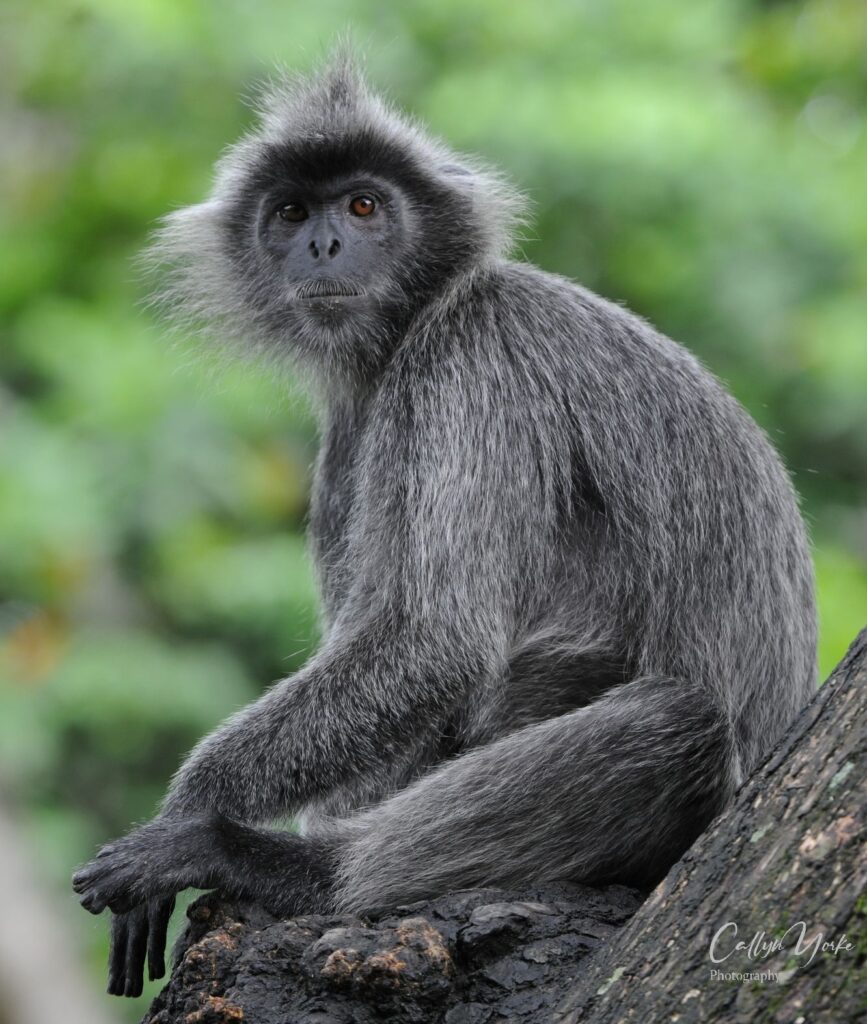
Scroll down for an Annotated Bird List
Introduction
Forty-two years had passed since I had been in Malaysia. Accordingly, I expected changes. What I found, particularly in the capital city of Kuala Lumpur, was scarcely recognizable. This brief memoir, focused largely on birds and natural history, is based on a reunion with a country where I was a US Peace Corps Volunteer from 1977-80.
I wondered if there was anything familiar left to be found in the rest of Peninsular Malaysia, which once supported the world’s most ancient tropical rainforest ecosystems. A portion of this visit included a road trip deep into the central peninsula; a partial, cross-sectional sample of Malaysian geography. What I found outside of K.L., were landscapes dominated by an endless sea of oil palm, the premier cash-crop for both Malaysia and Indonesia. Most of the original forests had vanished. Occasionally, at higher elevations, we sped by patches of tall, secondary rainforest, e.g. Ulu Gombak. Villages had become towns and towns small cities. We had to travel far indeed, more than 100 km from Kuala Lumpur, to find an example of the old Malay rural charm, e.g. Kuala Tahan. Cross-country roads and highways had been re-engineered, enlarged and improved for high speed traffic. Endless lines of logging trucks, antique British cars, rickshaws, bicycles and open-range livestock, had all but disappeared. Malaysia, it seemed, was now living in the fast lane.
The largest Malaysian city, Kuala Lumpur, I recalled as essentially a frontier town, bordered by old rubber-tree plantations, established during the colonial era with workers imported from India. Between those plantations, mostly in the foothills, were the scattered fragments of an incredibly diverse tropical rainforest. Hornbills, barbets, kingfishers and other colorful forest birds were common. The city itself appeared rather battered and worn, decaying around the edges, with black mold streaking down the sides of buildings and soot-covered trees lining the streets. The architecture was largely unremarkable, except for the train station, which appeared as though it had been hijacked from Istanbul and abandoned in the center of Kuala Lumpur. The city was essentially an organic collection of colonial buildings with rattling, dripping air conditioning units bolted to every office window. The impression I often had, was that of a tired old city patiently waiting to be recycled back into the forest ecosystem. It was a city that, through the years, I learned to love in my own, critically immature way (I probably had read too many issues of Mad Magazine as a child), and where I could find my way to a banana-leaf Indian kedai, camera repair store, movie house and post office, easily on foot and by using the rickety yet dependable Sri Jaya city busses.
Those days are long gone. In less than four decades, Kuala Lumpur has been transformed into a formidable jungle of glass, metal, marble and concrete. I was reminded of the sepia black & white photos of San Francisco during the Gold Rush era, compared with how that city looks today.

Gazing out the window of my 11th floor room at the Hotel Majestic, I was utterly lost in a maze of new freeways, billboards, overpasses, causeways and boulevards — a mosaic of contemporary architecture, including impossibly tall buildings that blocked the sun and probably confounded the daily weather forecast.
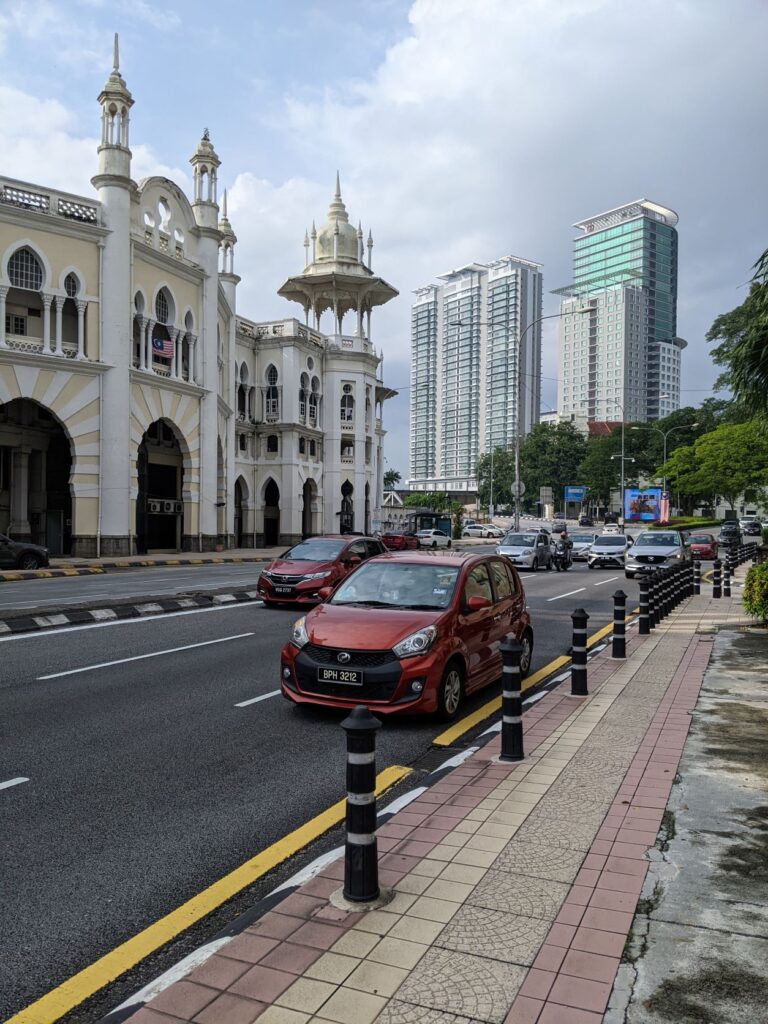
The sleepy little suburb of Petaling Jaya (PJ) had also been transformed into a complex network of new roadways and buildings; the old Bukit Kiara rubber-tree plantation, where my students and I had conducted field studies in avian ecology, had been replaced by a neighborhood of upscale homes and apartments.
The day before my return flight, I hired a taxi driver to help me find the house where I had lived in Petaling Jaya. It was somewhere in Section 17. That was about as much useful geography as I could remember. I had long since forgotten the numbered street address, resulting in the driver and I being equally disoriented while patrolling the streets.
This middle-aged fellow of South India ancestry, had a good command of English and friendly disposition. The scope of our mission, on a geological time-scale in his view, had captured his imagination. Forty-two years ago, he was a small boy living in Kuala Lumpur. I was a young lecturer at UKM. Perhaps we had already met on a bus somewhere in the city. The world is full of strange and wonderful, mostly forgotten coincidences.
All of my uncertain navigational instructions were gracefully followed. “Let’s try this street. No, this isn’t it. That gas station wasn’t here before. Over there looks good. Turn right, please.” We eventually ended up in what appeared to be remnants of my old neighborhood. Finally, we passed a home that looked vaguely familiar.
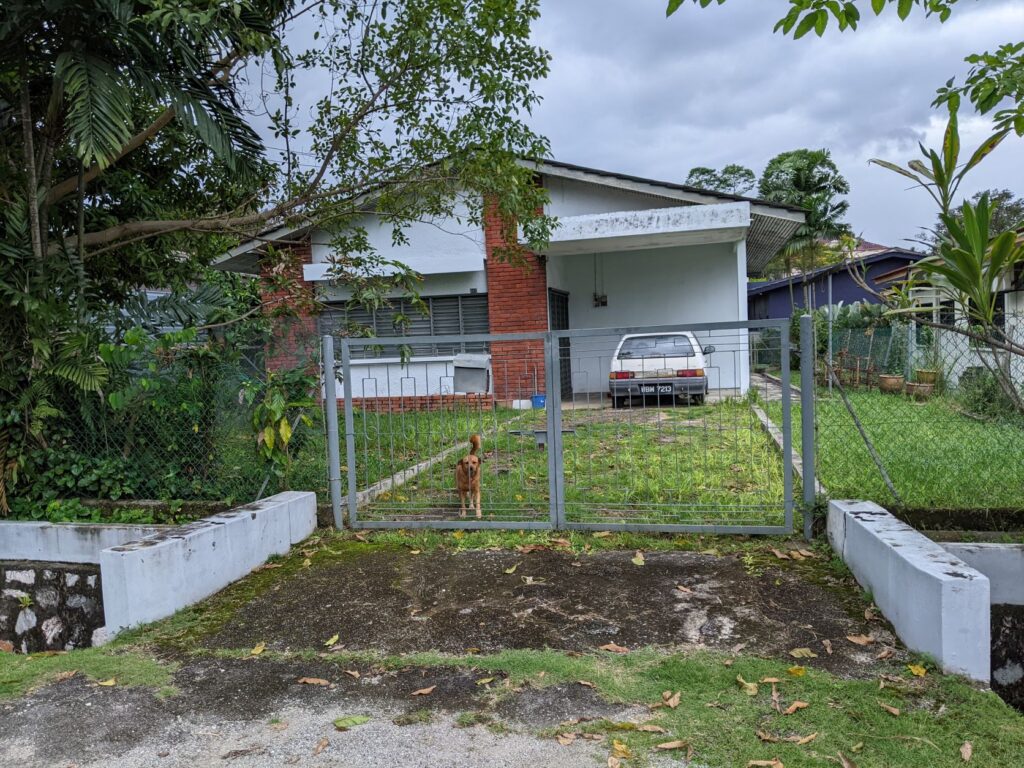
I got out of the taxi and approached the gated front yard. A lonely dog came out quietly to greet me, tail wagging, as if it had recognized a friend. A warm feeling of nostalgia swept over me. Yes, the roof angle, front porch, doorway and large, louvered living room window – everything looked right. It was one of the few homes in the neighborhood that appeared to be the original construction. I made a couple of snapshots with my cell phone and convinced myself that it must be the home where three young American Peace Corps Volunteers lived while lecturing at the University Kebangsaan Malaysia (UKM). This was almost a homecoming, except the old neighborhood was now inhabited by complete strangers. These folks, many of whom had not been born before I left in 1980, would have no idea that some of the most formative years of my career as a Biologist occurred while living in Petaling Jaya. I should explain.
The quaint, middle-class neighborhood of Section 17 in PJ, also housed several British colleagues from Cambridge University, e.g. Dr. Michael Kavanaugh, senior primatologist, supervising student researchers, including Joules Caldecott, who was studying the Pig-tailed Macaque. Dr. David Chivers, residing in the UK, directed the Cambridge group and obtained funding for their projects. He made a social visit once in PJ and had some insightful remarks regarding my avian ecology studies in a nearby rubber tree plantation. Bristol University was represented by Dr. Clive Marsh, specializing in comparative primate behavior and ecology. Clive, a sharp-eyed field biologist, was a good companion on field trips into forested areas on the western peninsula. I enjoyed learning about the amazing diversity of primates in Malaysia, a subject that I grew increasingly fond of as a result of contact with Clive and his group.
In fact, due to a pressing need for conservation of the disappearing forests and their unique animal inhabitants, most of the UK folks living in Malaysia were involved with primate research, which was well funded and in its heyday during the late 1970’s. Visiting scientists, some quite well known, such as, Thomas T. Struhsaker, a primatologist who spent a lifetime in East Africa, occasionally dropped in to see what was going on in Malaysia. We all appreciated the time allotted for socializing and an exchange of academic ideas. Those were some memorable moments for everyone involved, I’m sure.
Birds were a popular research subject in Southeast Asia, though not as much so as the primates. Field Ornithology in the tropics continues to be as challenging as it is exciting. Accurate identification of the groups with similar species, requires many preliminary hours of careful observation and demonstrable expertise, before reliable data can be collected. The 1975 publication by Ben King, A Field Guide to the Birds of Southeast Asia, the first comprehensive bird guide for the region, stimulated an increasing interest in the subject; that was definitely true in my case (a heavily annotated, tattered old copy of the field guide, today rests securely with my most important documents at home).
Some of the young scientists from the UK, namely Andrew Johns and Geoffrey Davison, were, like myself, involved with graduate-level, field Ornithology projects in Peninsular Malaysia. Andy Johns bravely camped out alone for weeks in a soon-to-be-logged primary rainforest, collecting biodiversity data on the birds and other animals. Geoffrey Davison who, at the time was patiently researching the stunningly ornate and rare Great Argus in Malaysia, had assisted me with my Zoology lab classes at UKM. He took over that teaching position for ten years after I left Malaysia in 1980, while earning a Doctorate from University Malaya (UM) under the guidance of another British ex-pat, Dr. David Wells. As the leading, long-term Ornithologist in Malaysia, Dr. Well’s occasional assistance with my field research was much appreciated. Dr. Davison, perhaps Dr. Well’s most famous student, continued to publish in the scientific literature, and authored two field guides to the birds of Malaysia.
All of us in those days were young, highly motivated field biologists. We had often met at each other’s homes for socials and casual discussions regarding our research projects. An American couple, Dr. Wendell L. Wilson and his wife Jasmine, from the University of Washington, lived a few doors down from us. Their place was often the focal point for our get-togethers. Wendell, a well trained behavioral ecologist, had studied under Dr. Gordon Orians, a first-rate scientist in the American Ornithological community. We soon became acquainted with each other’s academic background and current work. Thereafter, using friendly, constructive criticism, we refined our thought processes regarding the methodology and significance of each research project.
Those discussions turned out to be very important in shaping my avian ecology studies, which, except for occasional written correspondence with Dr. Douglas A. James of the University of Arkansas (who would eventually become my major professor after I left Malaysia), were, at the time, largely independent of academic guidance. In retrospect, our Section 17 Petaling Jaya neighborhood included one of the finest assemblages of field biologists I had ever known. I sometimes felt as though I had been too hastily inducted into the prestigious Royal Society of London; these people, the Brits in particular, really knew their subject material quite well. And, If you wanted to talk shop with any of them, you had better have your shit wired tight.
My head was spinning on a merry-go-round of fond memories. The driver and I high-fived. We were as happy as a team that had just won the World Cup. When we arrived back at the hotel, The doorman, smiling and wearing a pith helmet matching the gleaming white British officer’s uniform, was looking like he just stepped out of a Jumanji sequel. Although this wasn’t much like the Kuala Lumpur I remembered, it was a distant time of my life in Malaysia that I had touched in a profound way.
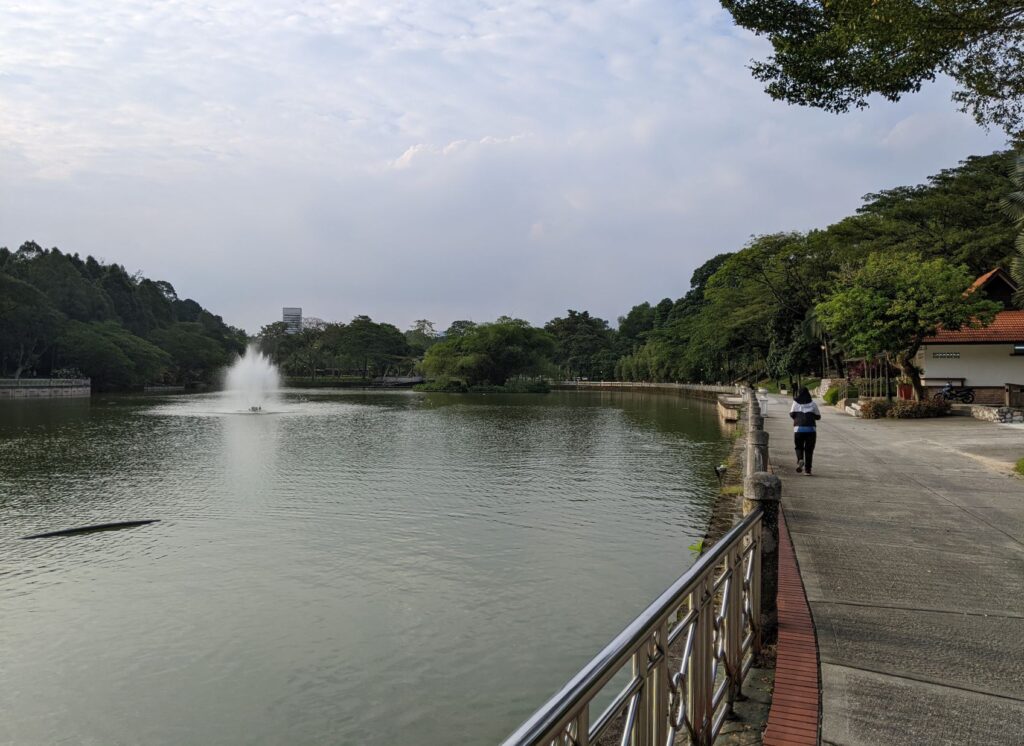
Three weeks prior to my arrival in Malaysia (September 8, 2022), I had booked a few nights in the national park, Taman Negara, Pahang, which was a four-hour drive from Kuala Lumpur. I chose to stay in the Hotel Majestic (5.5 Star – my rating) in central Kuala Lumpur for the first and last days of my visit. Established in the 1930’s, the Majestic appeared to be a decent, nearly affordable hotel (averaging $US 200/day, including superb dining) with a fair measure of British Colonial charm. Best of all, the hotel was a five-minute walk from an outstanding birding spot, Tasik Perdana (photo). It was an ideal, though a bit of a pricey choice for lodging in Kuala Lumpur. I certainly wasn’t disappointed. My bird list for the Malaysian trip was incrementally enhanced from an afternoon and morning survey through Tasik Perdana (see Annotated Bird List).
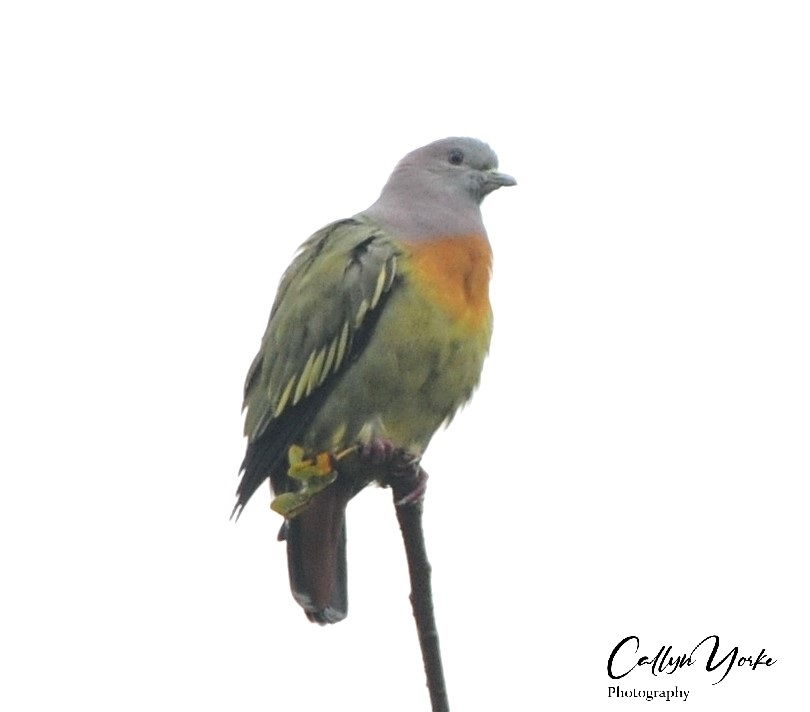
My final day in Malaysia on September 18, 2022, had a full agenda, which began with a search for a carrom board and a few travel-kit items; a noontime visit to my old neighborhood in Petaling Jaya (described above) and a late afternoon visit to a nature park in Kuala Selangor (see below). All of the objectives were met for that quite remarkable day. Dass, the Hotel Majestic concierge, made my transport arrangements with the utmost efficiency and lowest fares possible, e.g. $US $78 for the 140 km roundtrip to the Kuala Selangor Nature Park.
Everything on my shopping list was found in the multilevel, multi-hectare, Mid-valley Mall in downtown Kuala Lumpur. Obtaining a carrom board was another ‘mission nostalgia’ objective during my Malaysian journey. Although I had my old carrom board at home in California, I really missed being able to play the game at my current residence in the Vietnam highlands, especially during the rainy season. I combed through Internet listings. There were evidently no carrom boards sold in Vietnam or Thailand. Same for Cambodia and Laos. Culturally, that almost made sense. Malaysia, with a sizeable population of Indian descent –many of whom still enjoy their original board game — was the only nearby country where a carrom board might be purchased. Notwithstanding an encouraging Internet discovery, finding a specialty game store involved making several inquiries in Kuala Lumpur. There again, Hotel Majestic staff workers came to my rescue and directed me to a shopping mall where I would be most likely to find a carom board.

In fact the huge AEON store (Malaysia’s answer to Walmart) inside the Mid-Valley Mall had several carrom boards; I selected one that looked perfect and brought it back to the check-out counter. Some of the customers in line were amused. But there was still one problem remaining: getting the board back to Vietnam on the plane.
The following day at the check-in counter, Vietnam Airlines requested nearly $US 100 (cash only) to include the carrom board as an oversized item with my luggage. I was miffed. The carrom board plus a few accessories had cost me only $US 35. I must admit to having been a little impatient with the airline supervisor, summoned for assistance. Wearing a surgical face covering and with the right side of his glasses rapidly fogging up, the young man unilaterally dismantled the Skyteam partnership of Vietnam Airlines with Delta Airlines (USA). It appeared as though I had lost the argument and had only two options: pay the excess baggage fee, or abandon the carrom board at the airport. But when brought up online, the numbers provided by my Delta Skymiles account conclusively resolved the issue in my favor. The shiny new carrom board is presently awaiting its opening season tournament, just as soon as I can show my Vietnamese neighbors how the game is played!
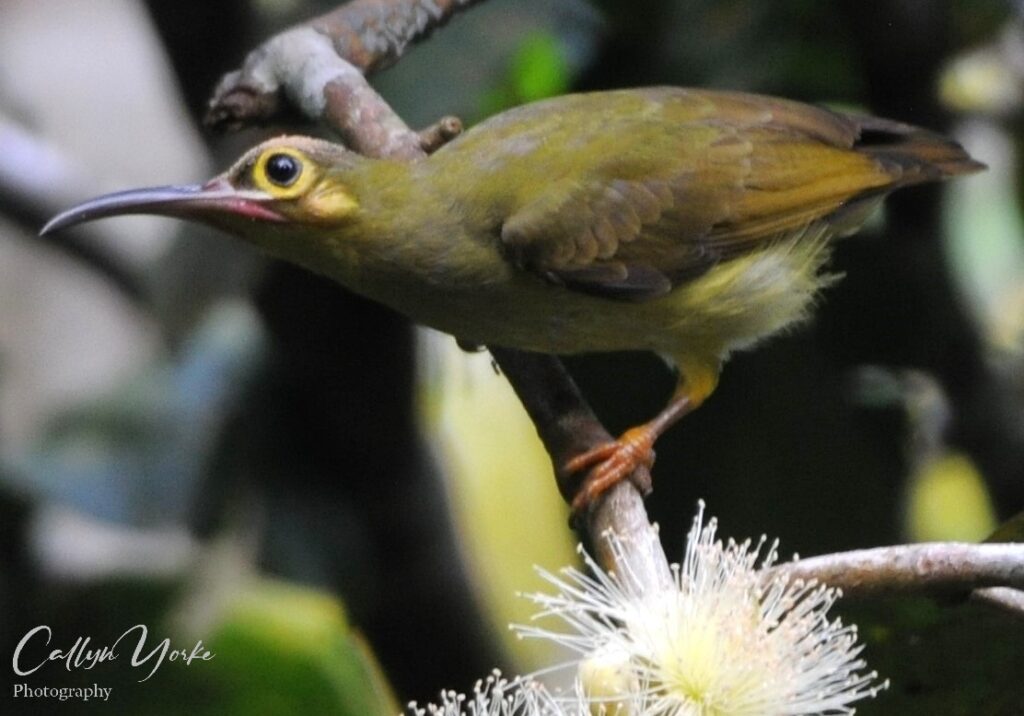
On The Road: Survey Areas, Materials and Methods
I visited three principal areas for birding and wildlife photography, Tasik Perdana, Kuala Lumpur (two surveys); Taman Negara, Pahang (multiple surveys); Kuala Selangor Nature Park (one survey). At all of those locations, I used a Zeiss 10 x 42 binocular, Nikon D3X camera with a Nikon 200-500 mm lens. A Google Pixel 3X cell phone was also used to document locations, signage, etc.. Birding surveys were conducted on foot, using a pocket field notebook; field notes were reviewed and recopied each evening into a larger format, loose-leaf notebook. When bird identifications were in question, descriptive notes and digital images I captured in the field were compared with information and images gleaned from reliable internet sources, i.e. Birds of the World, Cornell University, USA.
- Tasik Perdana, Kuala Lumpur (TPKL). Elevation, 94m. I made two walking surveys, visually covering approximately 70% of the 91-hectare park, on 8 September, 2022 (1700-1850 hrs.) and 9 September, 2022 (0700 hrs. – sunrise – 0920 hrs.). Weather during the surveys was overcast with little or no wind; temp. 29C to 32C. Many joggers and other visitors were present on the pathways through the park during the surveys, though most birds appeared to be fairly well habituated to human presence. A lake (Tasik Perdana) with a large fountain and small islet at the north end, initially appeared suitable for waterbirds but supported only a few domesticated ducks, as far as I could see. The west and especially northwest sections of the park, had pathways bordering a closed canopy of tall rainforest trees, where most passerine birds were found. Elsewhere, birds were found in flowering shrubs and trees; those bearing small fruits were especially favored. A large aviary in the southeast section, enclosed by nylon mesh netting, attracted several species of waterbird unseen elsewhere in the area, e.g. Painted Stork and Hadada Ibis. Those birds were free-ranging and evidently spent several hours each day standing on the nylon roof netting, visiting their incarcerated relatives.
2. Taman Negara, Pahang (TN). Elevation, 85m. I made walking surveys each day, during the morning and late afternoon, visually and collectively covering a total area of about 25- hectares in the Mutiara Resort gardens and adjacent boardwalks through mature, closed-canopy, riverine rainforest (10 -17 September, 2022); the Sungei Tembling and Kuala Tahan river sections next to the resort were also surveyed visually each day. Weather during the surveys ranged from heavy overcast with light rain to fair and warm; temp. 26C to 32C, with occasional light afternoon winds (2-5 kph). Stationary surveys, e.g. from the dining area and floating restaurant across the river, were made daily. Evening, walking surveys were made; those were focused mainly on attempting to identify nightjars foraging around the outdoor lamps and porch lights.
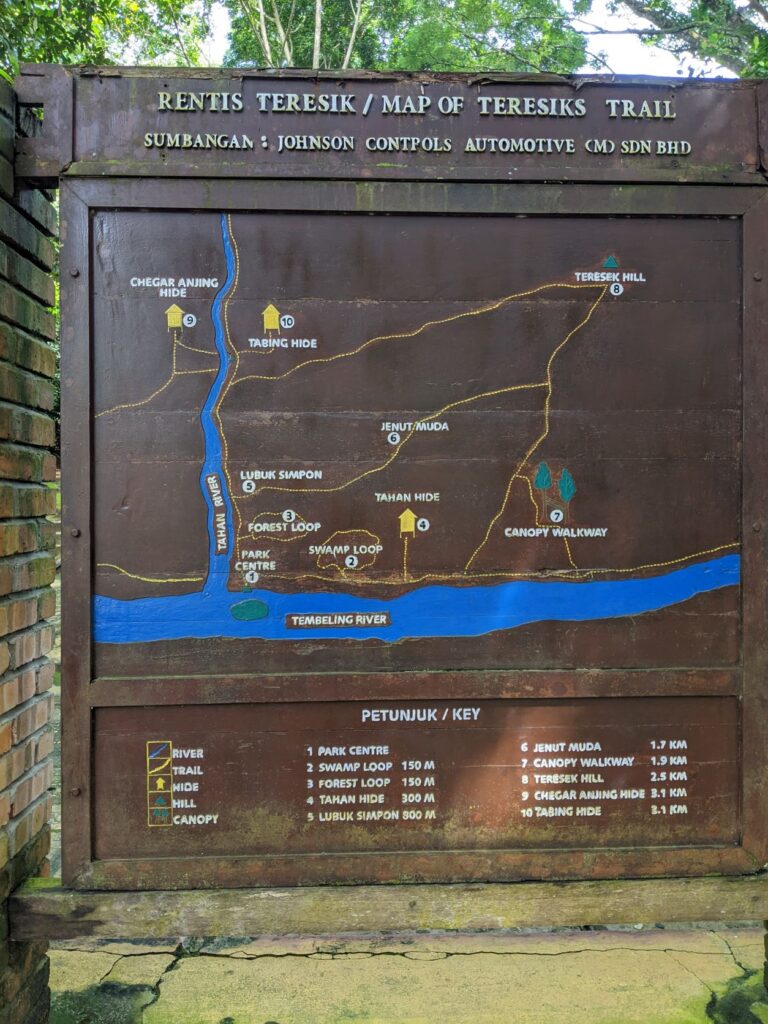
Trails in the Mutiara Resort area consisted primarily of fiberglass boardwalks, often in disrepair due to tree-falls, elephants and ordinary wear and tear from thousands of visitors using those walkways each month (several hundred people were present at the resort during my visit).
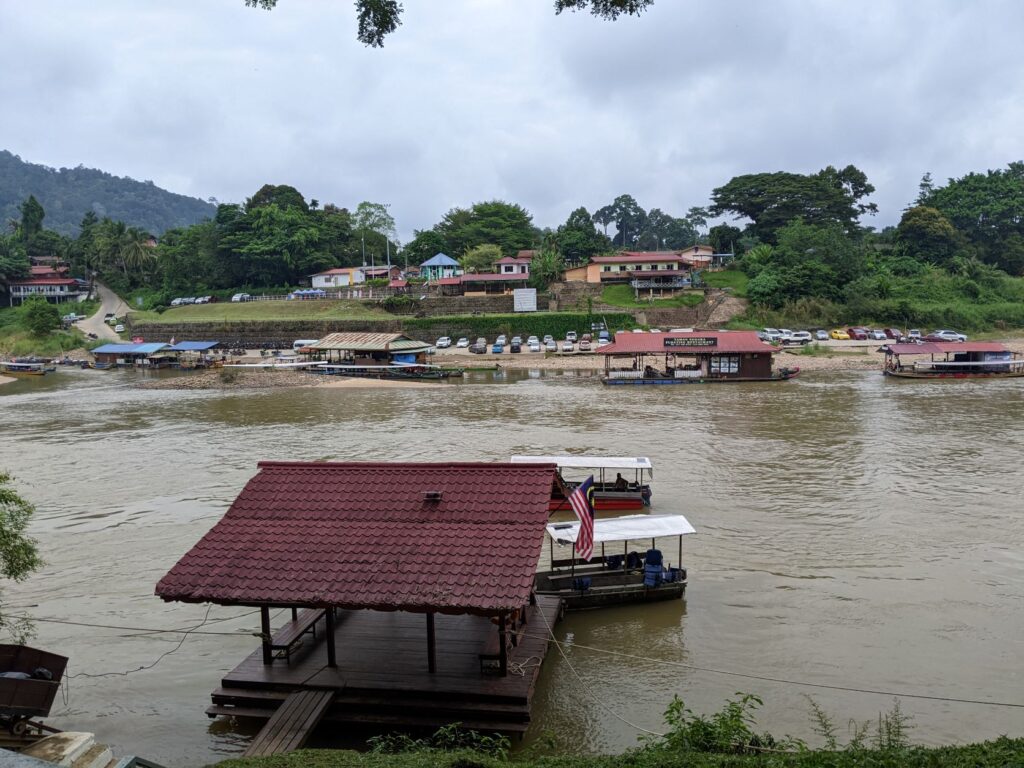
Creaky, loose and broken fittings between boardwalk planks, made walking quietly through the forest on designated trails, nearly impossible. That, combined with noisy groups of visitors, who appeared to have little interest in observing nature, resulted in a number of my surveys being interrupted; there were multiple instances of birds frightened away before they could be identified and photographed.
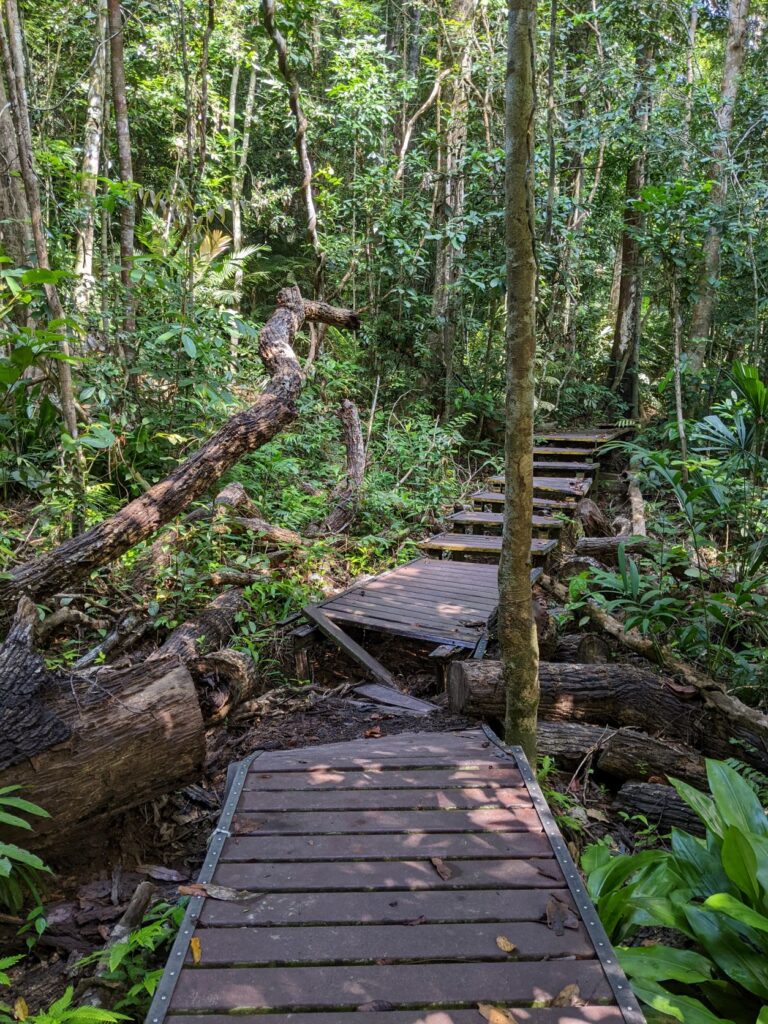
Trails I frequented (see above map) included Swamp Loop (SLT), Tahan Hide (TH) and Lubuk Simpon (LS). I made less frequent surveys on other trails, e.g. leading to the Canopy Walkway (CW – an extremely narrow, wobbly suspension bridge, unsuitable for wildlife observation and photography).
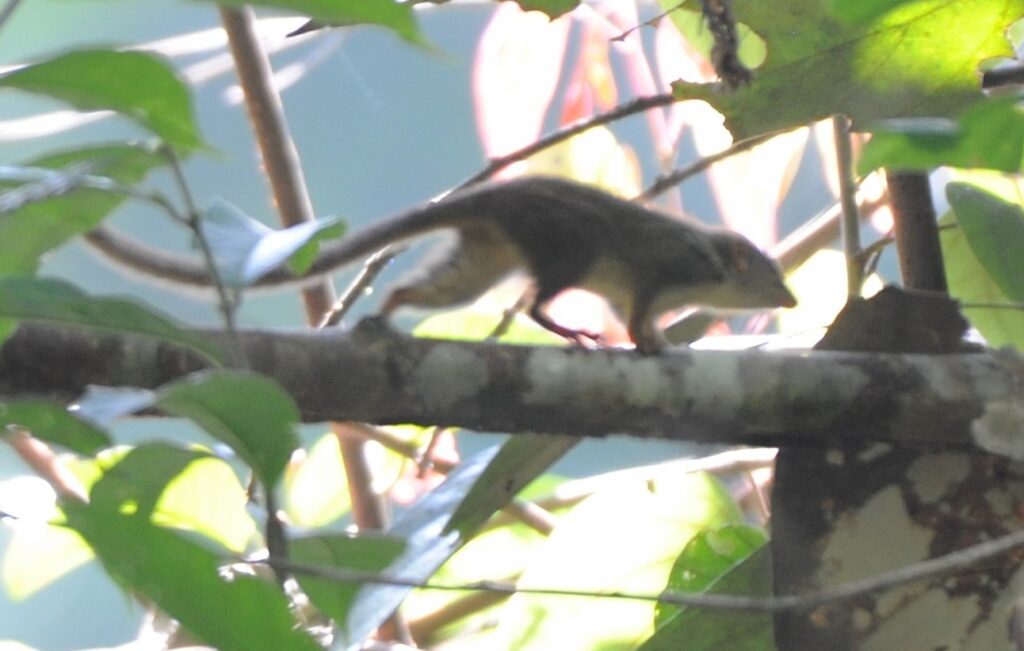
The best area for bird photography was generally around the resort gardens, where flowering and fruiting trees attracted numerous species. There, birds were accustomed to human presence (except for an hour or two, early every morning, when a gas-powered leaf-blower was being used, apparently to awaken the dead). But even with a habituation advantage on the resort grounds, lighting conditions were seldom optimal, as an upward angle of the camera into a tree canopy, often incurred harsh backlighting. Overall, I was mildly disappointed by the lack of photographic opportunities. Similar reports were found online among photographers visiting Mutiara and Taman Negara.
A daytime bird feeding-photography station, set up at one of the nocturnal, mammal-viewing hides (e.g. Tahan Hide), would likely solve that problem. Mealworms (beetle larvae) are a safe, nutritious food, eagerly consumed by many kinds of wild birds and small mammals. A mealworm colony of sufficient size can easily be established and maintained using plastic storage containers and food left-overs. Once birds learn the whereabouts of the supplementary food stations, they habituate quickly to human presence and can be observed photographed at close range in their natural habitat. This occasionally results in sightings and photo-documentation of rare species. Of course, the frequency of supplemental feedings must be closely monitored and controlled to avoid adverse ecological impacts on birds and other wildlife. Generally, most wild animals will continue to search for a variety of their favorite, natural foods, even when supplemental food is available.
When I suggested the feeding station option to one of the park officials, I was reminded that, except for salt-licks, supplemental feeding of birds and other wildlife in Taman Negara is expressly forbidden by law. Alright, fair enough.
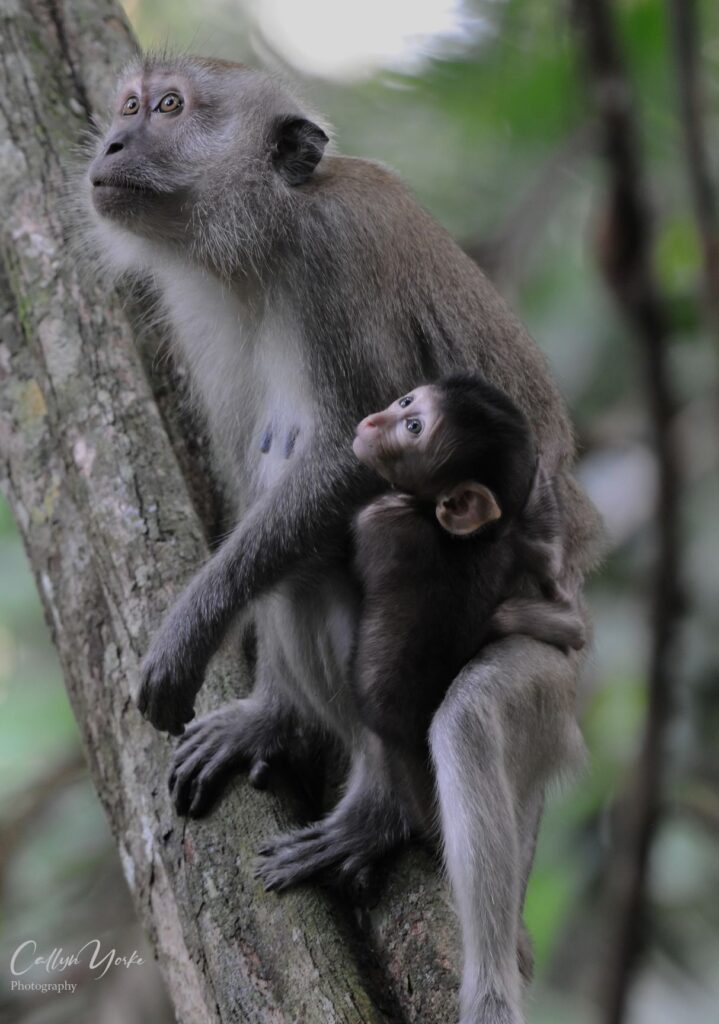
If only that same resolute ideology was uniformly applied to wildlife conservation and education in Taman Negara, significant improvements to the park facilities and services might be made. And therein lies one of the major shortcomings of the National Park system in Malaysia. The government relies on a high volume of traffic in the park; Ninety-nine percent of visitors are there for socializing and recreation; ecology and guided wildlife education programs would not generate much income and therefore are given little if any attention by the park authorities.
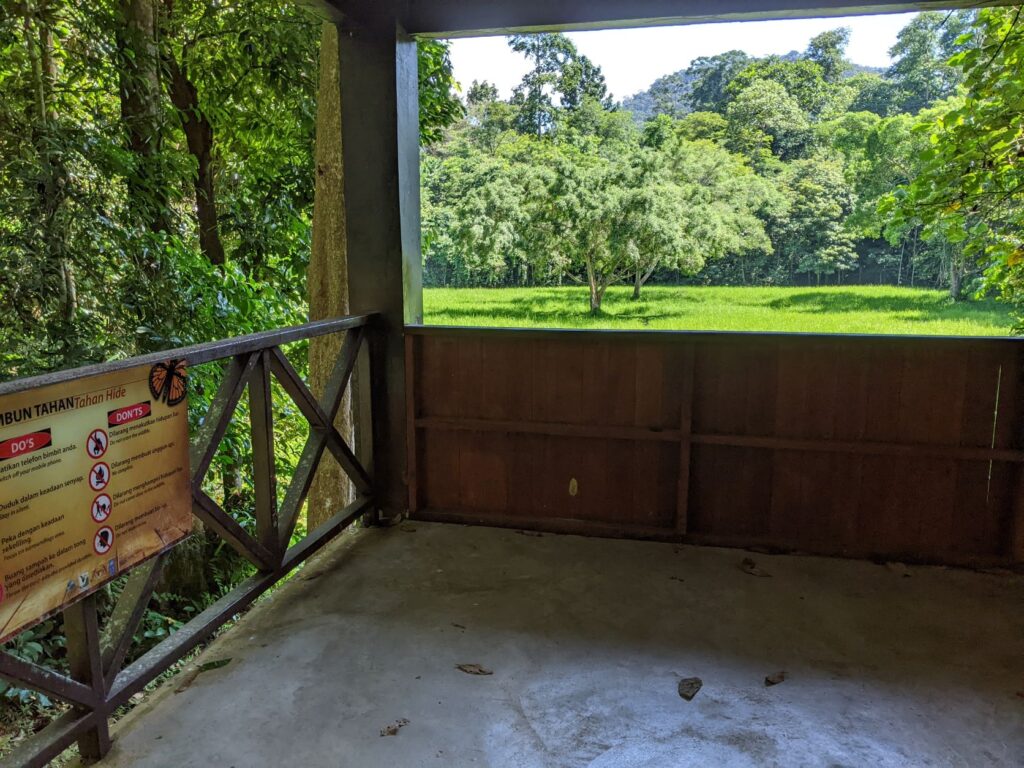
My booking at Mutiara included a series of emails with the staff. Specifically, they asked which of the many recreational activities I would like to sign up for, such as river-rafting, caving, canopy walkway, trekking, e.g. to Peninsular Malaysia’s highest peak, Gunung Tahan (seven days). None of those activities was of interest to me. I simply wanted to observe and photograph birds and wildlife.
If a park guide was available for a half-day bird-walk, that would be fine with me. But there was no definitive reply to my request. Apparently, Taman Negara did not normally provide such service, which was confirmed after my arrival at Mutiara.
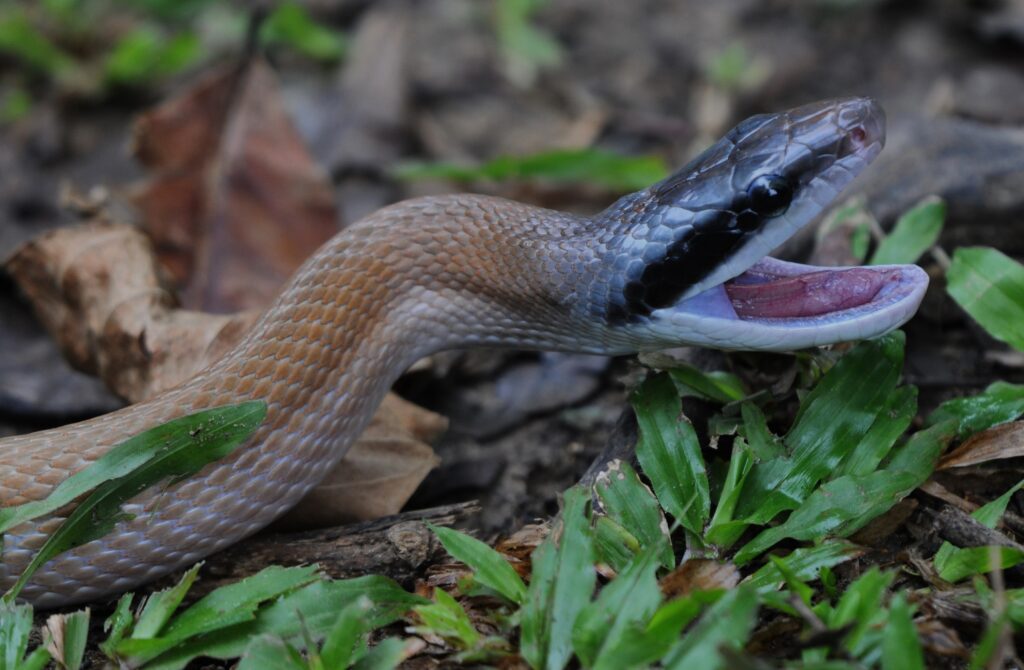
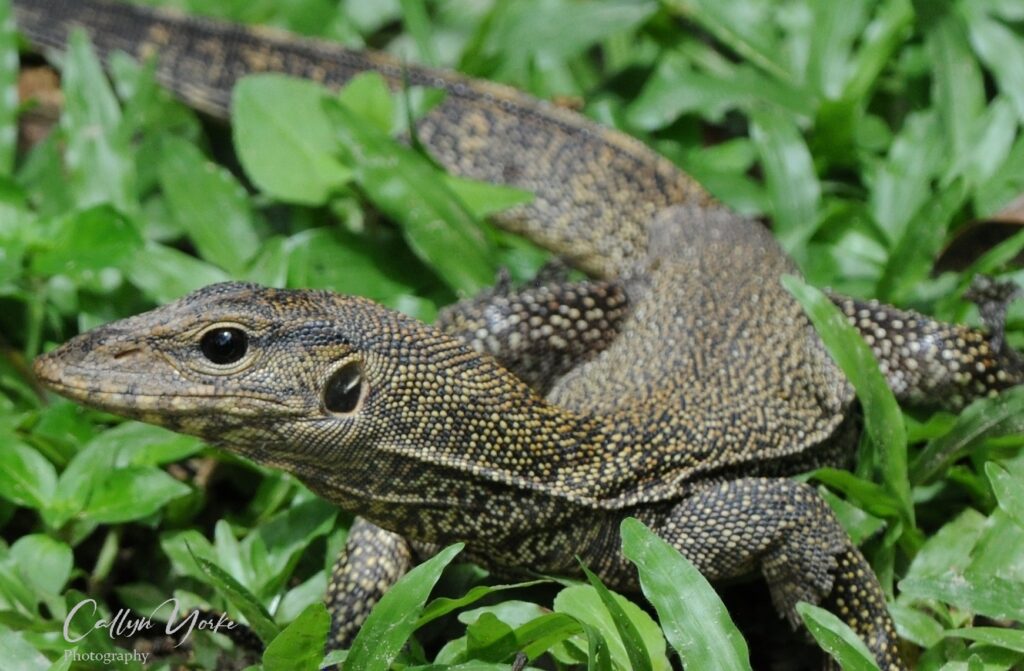
Not only were there no naturalist guides available in Taman Negara, the rangers and other officials residing in the park were usually unable to assist me with information regarding specific localities where I might find interesting birds and obtain photos. A white-board with a few, out-dated, fragmentary notes of sightings in the park, was secluded in the corner of the ranger station and apparently seldom used. I discovered it after four days into my visit. Park officials were clearly overwhelmed by the hoards of tourists in the park. They had their hands full issuing hiking permits, arranging boat trips and other recreational activities. I was on my own to find whatever I could in Taman Negara.
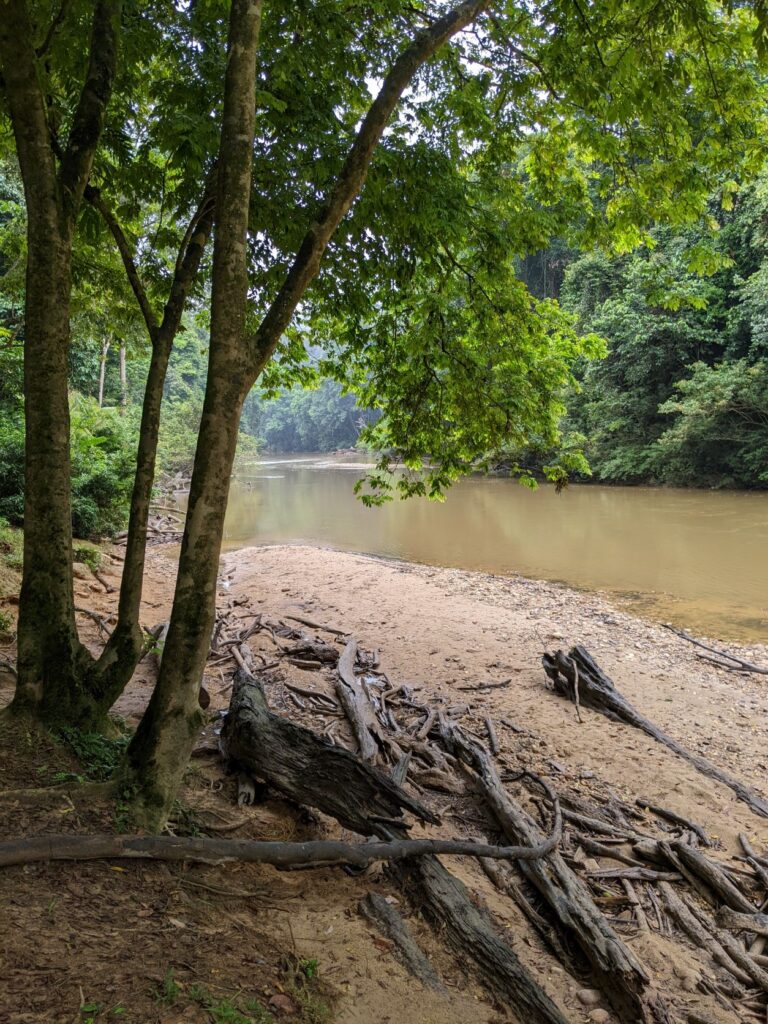
Fortunately, a few professionally led birding groups came through the park during my stay. A World Wildlife Fund group with two field biologists (one stationed in Nepal, the other in Cambodia) were in the park for an organizational meeting. Those people often had useful information regarding recent bird and wildlife sightings. It was clear that birders in Taman Negara should arrive with their own guides, essentially independent of park services and facilities.
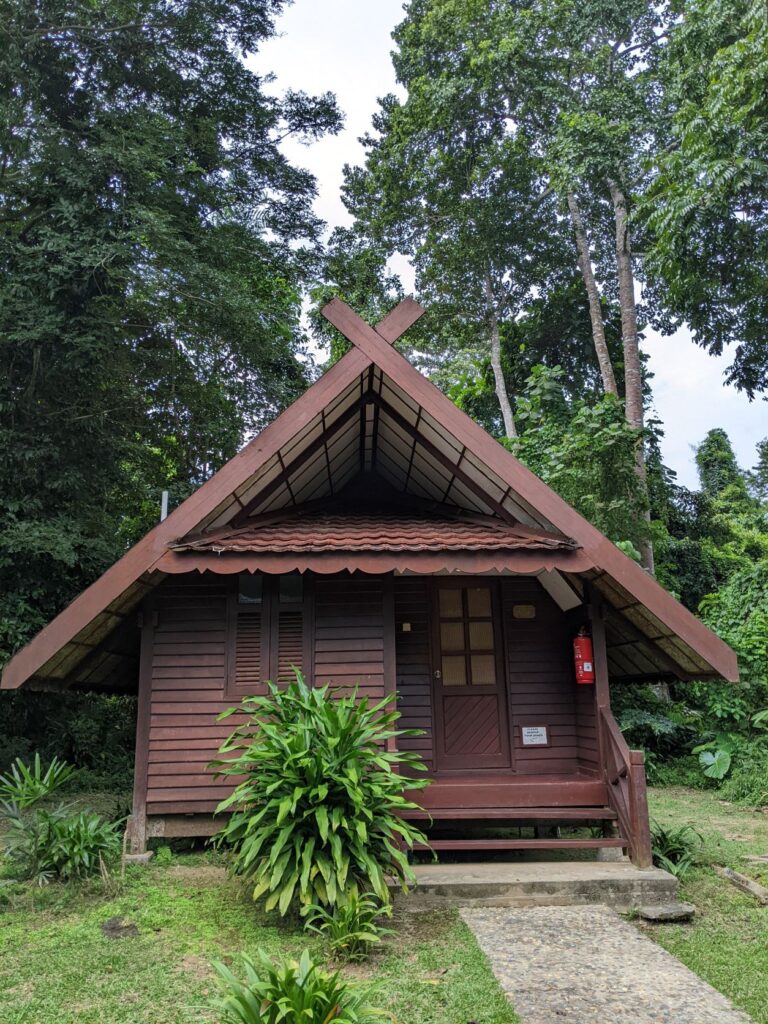
Lodging at the Mutiara Resort (1.5 Star – my rating) primarily consisted of a rambling series of 108 cabins. What appeared to be a large, abandoned bunk house with a badly damaged roof, was elevated on blocks in the middle of the cabin area. I guessed it may have been where our UKM classes stayed during field trips. I asked one of the Mutiara supervisors about it and he agreed. I was quite keen on seeing the old visitor logbooks, that I imagined should be in safe storage at the ranger headquarters. Alas, that turned out to be a fool’s errand. The visitor logbooks of those days (late 1970’s), in fact, all of the books, I was told, had been destroyed in a flood many years ago. That was indeed a great loss. Included with signatures, nationalities and dates, were comments regarding wildlife sightings and other noteworthy experiences; some visitors made maps, artistic sketches, cartoons and other creative contributions. The logbooks contained an irreplaceable, first-hand record of Taman Negara history. Sometime following the great flood and rebuilding of the facilities, the park service discontinued the use of visitor’s logbooks.
I was assigned to chalet #97 (photos). I found the rustic design and interior facilities to be clean and adequate, except for tricky, three-pronged, 210-volt electrical outlets, a leaky roof and a portable safety deposit box, small enough to be concealed in a backpack. The good news: I sincerely appreciated being far removed from the central reception area; the chalet was usually a quiet, pleasant retreat from all the commotion. More good news: the cost for lodging and most of my meals for a week-long stay was reasonable (averaging $US 100/day).
At daybreak, outside my window, a resident Magpie Robin (Copsychus saularis) would serve as a secondary wake-up call. This bird had been part of local folklore – a well known, accepted resident of towns, villages and rural areas throughout the lowlands of Southeast Asia, including our yard in Petaling Jaya. Unfortunately, Magpie Robin populations have declined in the region, due to its popularity as a cage bird. Protected areas, such as city and regional parks, are about the only places where these birds are still commonly found.
The primary announcement of a new day in Malaysia, was the hauntingly beautiful Muslim call to prayer, wafting in from a mosque across the river, like an old-time radio broadcast in carefully articulated Arabic phrases, building then fading in the heavy pre-dawn air. This was a familiar sound I had heard daily when living in Malaysia decades earlier. Hearing it again in Taman Negara, brought back sublime memories of my life in an exotic new land. The faithful practice of Islam by Malays, qualified as one of the few unchanged aspects of Malaysian life. I could be wrong, but after staring at the ceiling in my room one evening, I concluded that an arrow above the ceiling fan pointed to the direction of Mecca.
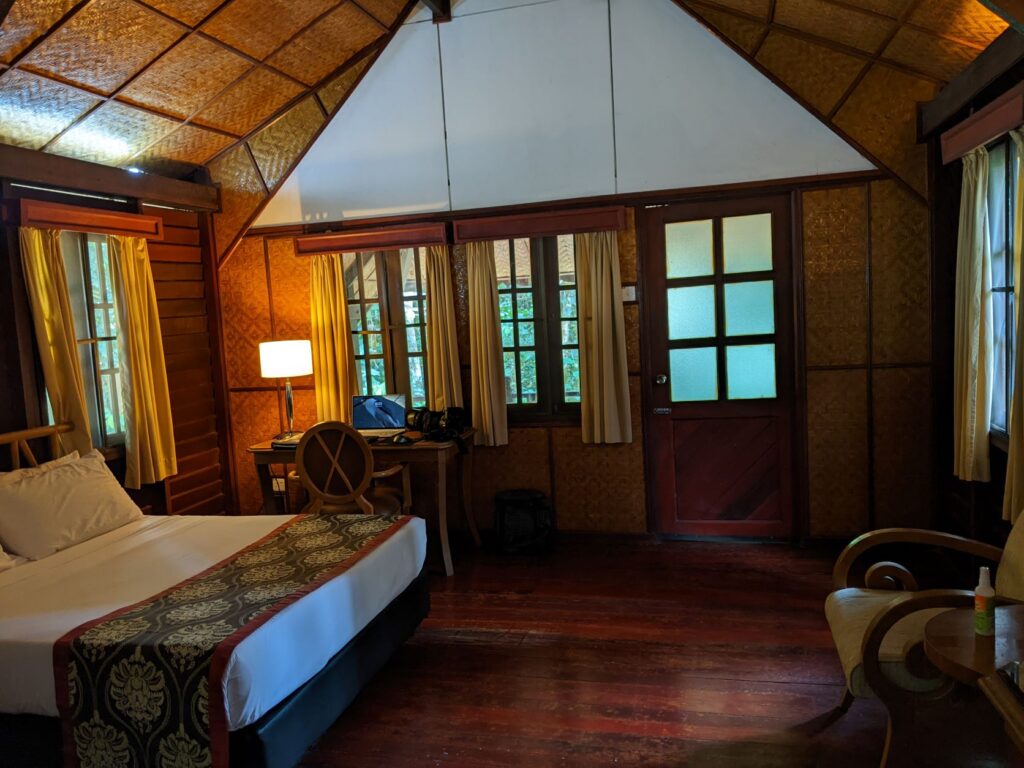
Most of my meals were taken in the Mutiara Resort dining area, where a buffet-style service supplemented a decidedly limited kitchen menu. The quality of prepared food was satisfactory — mainly rice with Malay-style meats and vegetables cooked and stewed with heavy sauces.
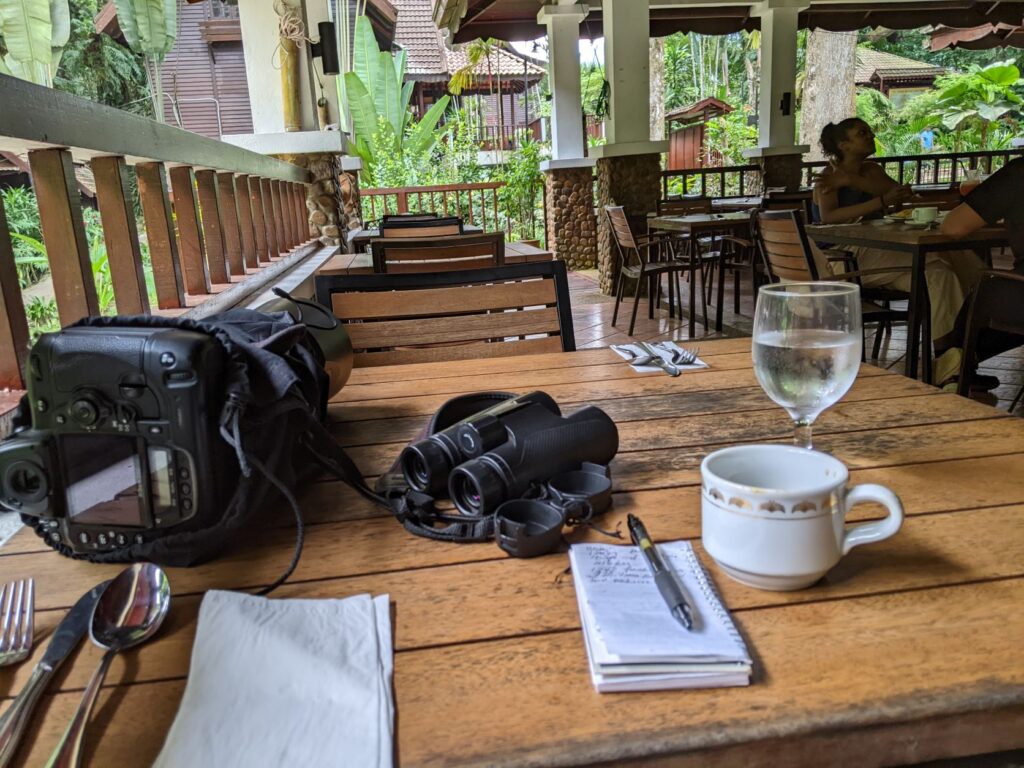
The daily salad and fruit selection was fresh but lacked variety. However, that deficiency failed to discourage the non-paying guests. Once, a determined Long-tailed Macaque boldly raided the fruit bar. After alerted by my loud hand-clapping, and two more of its failed attempts to reach the fruit selection, the uninvited guest was chased out of sight by workers, shouting and waving their serving trays and sling-shots. The arrival of reinforcements and heavy artillery appeared to have settled the dispute.
Then there was a scene that might have surprised even the monkeys. The sliced fruit that the macaque perpetrator had been fingering, should have been removed immediately from the dining area, yet was simply repositioned and left for future guests. Hmm. I wondered what other horrors might have occurred in the kitchen behind closed doors.
Beer and wine were available to non-Muslim guests. A sign at the bar upheld the Islamic law, presumably as a reminder for Malay guests. Curiously, the universal admonition to “Please Drink Responsibly” printed on the back of beer cans, was given in Bahasa Malaysia.
Usually, when finishing a meal at the Mutiara Resort dining facility, I was still a little hungry. Certainly not starving, to be fair. Asian & Western style desserts, usually the first items to disappear from the buffet table, were among the most creative and tasty items on the lunch and dinner menu. Those included flan-like puddings, multiple-fruit Jello, and notably, a hot banana fritter with ice cream – prepared to order – that was awfully hard to resist.
Malaysians were definitely into their desserts, big-time. Tragically, as in America, obesity had reached epidemic proportions in Malaysia. To put it bluntly, fatties were everywhere, cardiologists were getting richer and the airlines going broke. Seeing overweight children was especially saddening. It was the omnipresent signal for me to be mindful of my daily food intake. After doing some mental math, I reasoned that lugging around heavy camera gear all day in the heat and humidity, left me with a caloric deficit. So, like a kid playing ball on a busy roadway, I accepted the risk and dove on the yummy, high-calorie dessert selections. How did the math work out? Not bad, really. Stepping on the scale when I returned home was almost a relief. I had stayed within one-percent of my starting, optimal body weight. That was sometimes a challenging task when traveling in countries with limited menus, e.g. Costa Rica: rice & beans, or beans with rice. Obesity, by the way is also a serious health problem in Costa Rica.
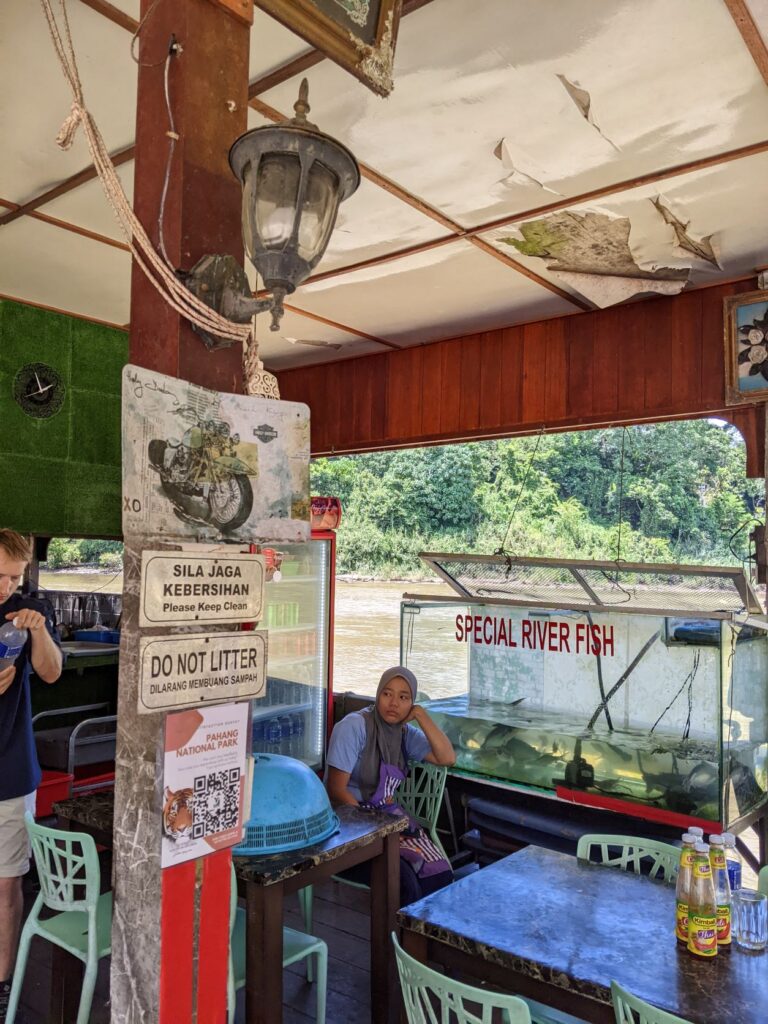
For variety at dinner time, I usually took a motorboat ferry ($US 0.22 each way) across to the Family Floating Restaurant. Their chicken satay was arguably the best in Malaysia. An added attraction was a close-up view of Germain’s Swiftlet and Pacific Swallow, coursing back and forth over the river, frequently skimming for a drink.
The Malay family operating the floating restaurant was friendly and welcoming, increasingly so with each of my visits. This was the most popular of the three riverboat restaurants in Kuala Tahan. Local fish were caught, live-tanked, and grilled to perfection. The owners knew exactly how to prepare a variety of delicious, Asian and Western style meals. Evidently, they also liked Harley Davidson motorcycles; two tattered old posters featured classic bikes as decorative memorabilia. This was my kind of place – a spicy, laid-back, old river ambiance, reminiscent of the deep South. Nothing was missing — okay, well, maybe a little ‘rollin on the river’ music from John Fogerty and Creedence Clearwater Revival.*
These were simple, honest-to-goodness back-country river folks. They knew enough English to serve foreign customers, though I preferred speaking with them in Bahasa. Like most Malays, they were delightfully surprised to meet a Westerner who could speak their language. Of course, that usually unleashed a barrage of rapid-fire questions and idioms that often required of me an extra moment to process and formulate a relevant response. No matter. Our small-talk, chit-chats were a delightful cross-cultural exchange, though I sometimes misunderstood them and answered the entirely wrong question! I’m sure they were amused; perhaps a tad more so than would have been my Peace Corps language instructors.
* Born on the Bayou -The Fogerty brothers, John and Tom, and their Creedence Clearwater Revival band, actually originated in El Cerrito, California. Coincidentally, the Fogerty brothers (there were five of them) and I attended St. Mary’s High School (an all-boys Catholic school founded by the Christian Brothers) in the adjacent city of Berkeley. At the time (mid 1960’s), while only a blip on my radar, the two older boys, a few of years ahead of me and subsequently, transferring back to El Cerrito High School, were emerging onto the San Francisco Bay Area music scene. Long disbanded now, the familiar vocals and guitar of CCR comes through loud and clear in the live performances and recent recordings by John Fogerty, (e.g. Deja Vu All Over Again, 2004), the group’s lead singer and songwriter. Regardless of their bayou-less, SF Bay Area origin, CCR is unquestionably ranked as one of America’s top classic rock groups; one that continues to twang the right strings for me, whenever one of their old songs is played, be that in California, Louisiana, Vietnam or Malaysia.
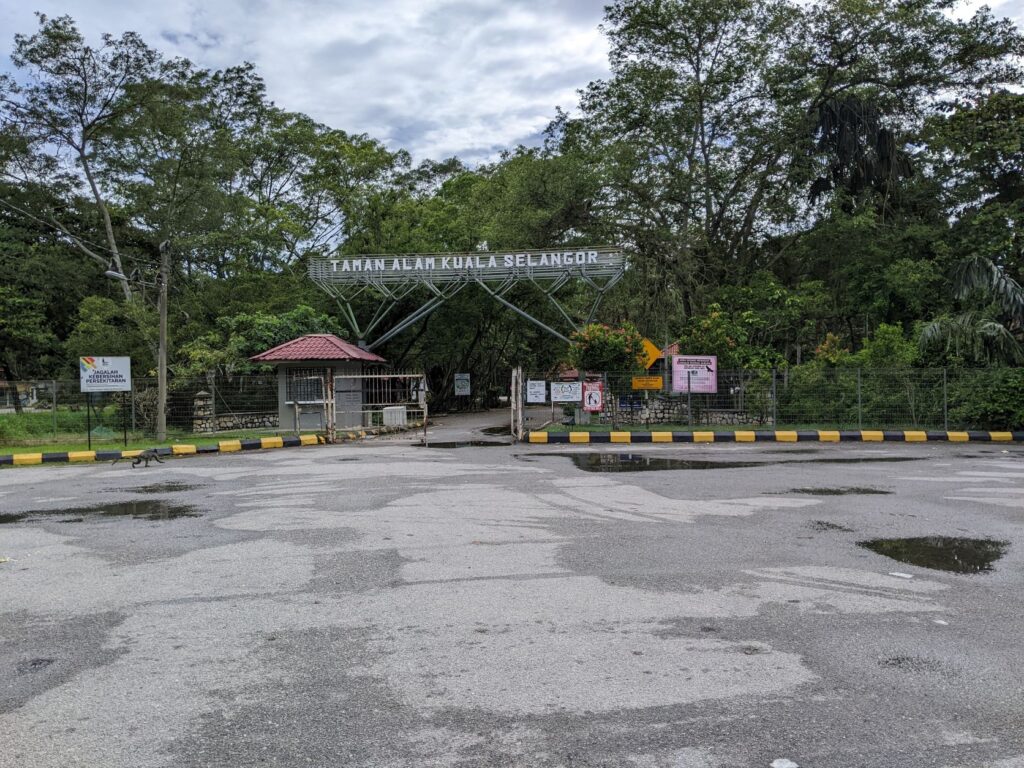
3. Kuala Selangor Nature Park (KSNP). Elevation, 7m. I made a single survey of the park on the afternoon of September 18, 2022 (1600-1720 hrs.). The park is located about 70 km northwest of central Kuala Lumpur and an hour’s drive in relatively light traffic. I spent most of the time in secondary forest area surrounding the visitor center, where the birdlife was relatively conspicuous. Several other visitors were in the park, some with small children. The staff in the visitor center was friendly and helpful, offering me a senior discount ticket ($US 0.50). They also suggested an orientation presentation, though I politely declined due to the late hour (the park closed at 1830 hrs.). I continued on westward pathways about 300m into the mangrove and canal area, without seeing much besides a troupe of the endangered Silvered Leaf-monkey (Trachypithecus cristatus) and the common, widespread Long-tailed Macaque (Macaca fascicularis). Mosquitoes were abundant and persistent throughout the park; I probably would have continued my survey westward in the park for another hour or so, had I remembered to bring repellent.
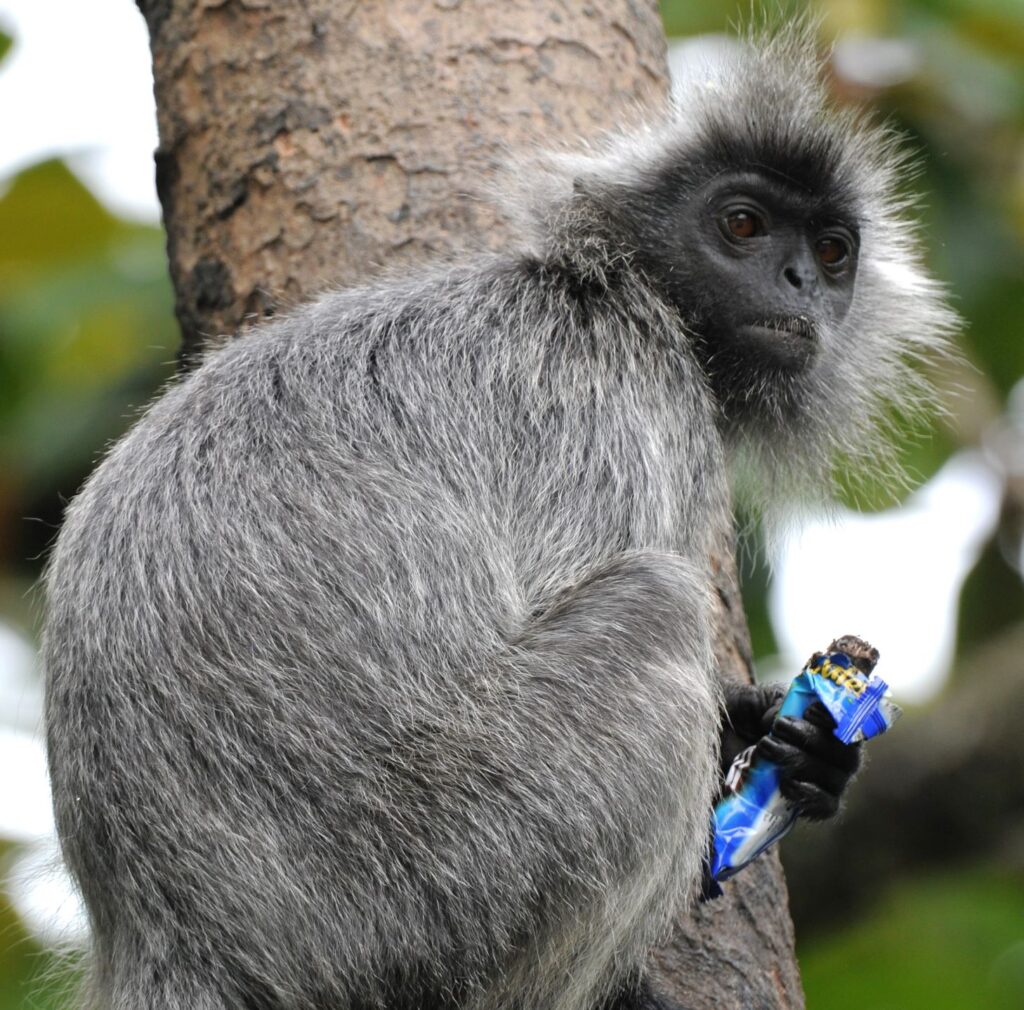
Photo opportunities of birds were few but best around the visitor center; a habituated troupe of at least thirty Silvered Leaf-monkey in the trees and on the ground, were easily observed at close range. Some of these monkeys were being hand-fed by people in the parking area. One of the monkeys held a partially consumed candy bar, apparently unsure whether it should be finished or kept as a souvenir (photo).
The Silvered Leaf-monkey, as the name indicates, has a highly specialized digestive system for processing foliage, which comprises 91% of their diet; the remainder of their diet is a small proportion of flowers, fruit and seeds. Unlike the Long-tailed Macaque, leaf-monkeys, while intelligent and curious, are poorly adapted for an omnivorous diet; a physiological limitation that probably has contributed to their regional decline in numbers. Feeding them packaged foods, such as candy and other sweets, is definitely ill advised.
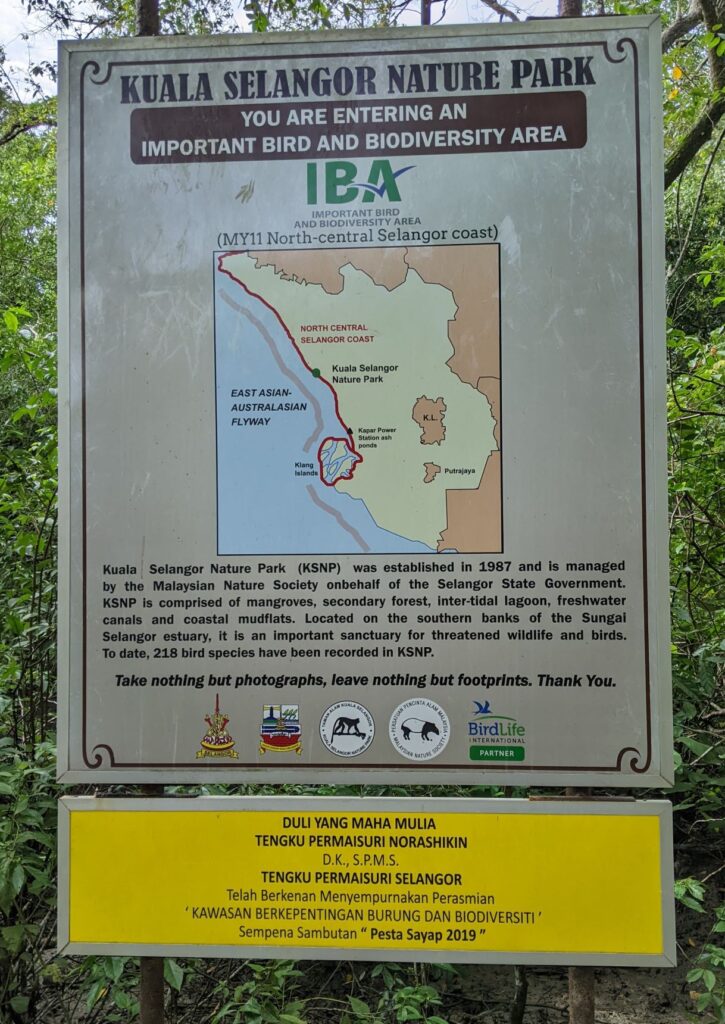
________________________________________________________________
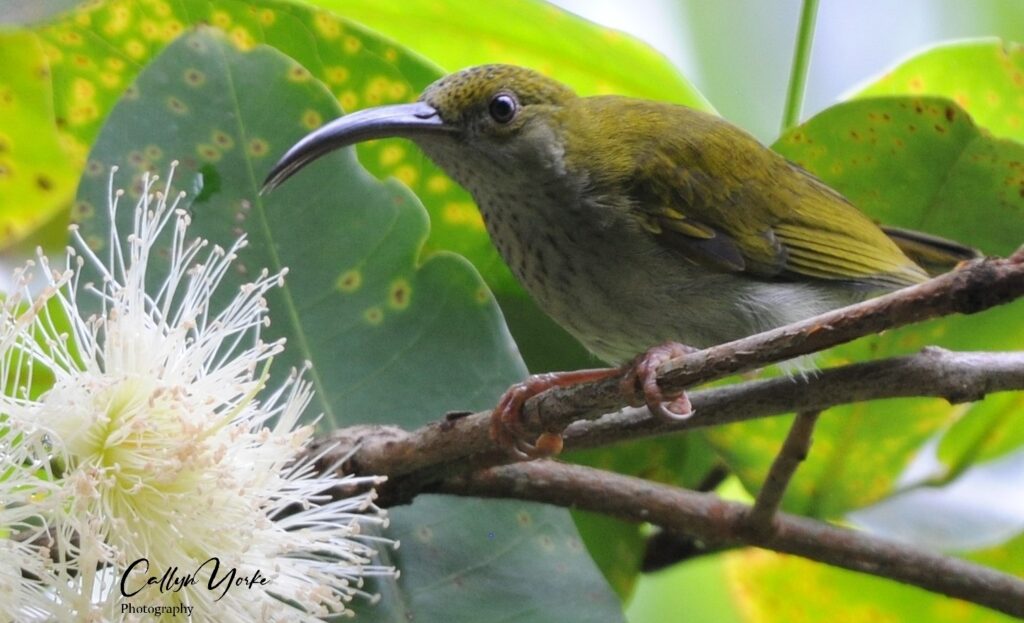
Annotated Bird List: Kuala Selangor Nature Park, Taman Negara, Tasik Perdana, Kuala Lumpur, Peninsular Malaysia 8-18 September, 2022 Callyn Yorke
Abundance: Numbers following each species entry are the maximum count for a single survey, when multiple surveys of an area were made Age, sex and molt (when known): ad = adult; imm = immature; m = male; f = female; bsc plmg = basic (non-breeding plumage; alt plmg = alternate (breeding) plumage.
Frequency: C = Common, i.e. found during all or more than half of the surveys in appropriate habitats; UC = found on fewer than half of the surveys; R = found only once. Note: these nonparametric categories are most appropriate for the Taman Negara (TN) area, where multiple surveys were made. The other two principal localities were surveyed only once, KSNP or twice, TPKL.
Localities & Distribution: Kuala Selangor Nature Park (KSNP); Taman Negara (TN), including Mutiara Resort and gardens (MR), adjacent forest trails, Canopy Walk (CWT), Lubuk Simpon (LS), SwampTrail Loop (STL) and adjacent segments of Sungei Tembling and Sungei Tahan; Tasik Perdana Kuala Lumpur (TPKL); see above Introduction for further location details; ubiquitous in the appropriate habitat (ubiq).
Ecology and Behavior: aerial insect hawking (ah); taking fruit, berries or parts of flowers (fr); gleaning insects from foliage (ig); estimated height (m) above ground (agl); gregarious (greg).
Systematics and Nomenclature used herein, primarily follows current (2022) online resources, i.e. Birds of the World, Cornell University, USA.
- Muscovy Duck Cairina moschata (exotic) 10 greg. swimming near the north islet in the main lake, C, TPKL
- Mallard Anas platyrhynchos domestic hybrid ? 1 the bird appears to be an immature in prebasic plmg. ; swimming with exotic MODU in main lake, TPKL (photo).
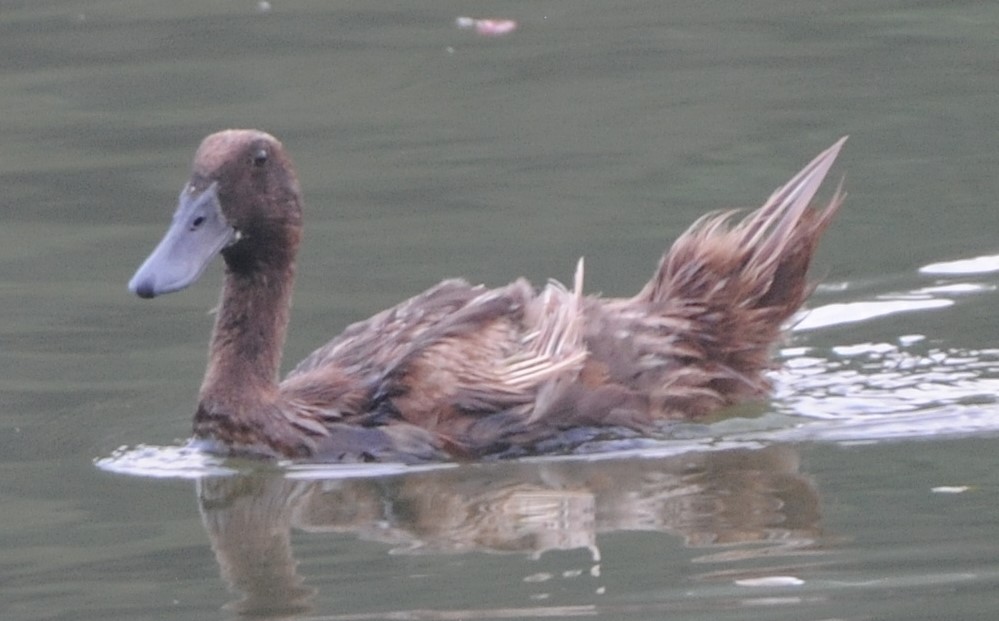
- Malay Crested Fireback Lophura rufa 8 (6m, 2 f) greg. a cohesive covey, walking steadily and quietly on the forest floor, then briefly onto and across the boardwalk about 10m in front of me, and continuing downhill through the forest; unfortunately, only poor-quality photos obtained due to constant movement and dim lighting, R, TN-STL (near junction with the Tahan Hide).
- Feral Rock Pigeon Columba livia 30 greg. on ground in north children’s playground, C, TPKL; ubiq. in cities and towns.
- Spotted Dove Streptopelia chinensis 6 vocal, greg. often paired, on ground, readily flushed to trees, C, ubiq. (not observed in TN).
- Zebra Dove Geopelia striata 12 vocal, greg. often paired on ground, C, TPKL; ubiq. (not observed in TN)
- Pink-necked Green Pigeon Treron vernans 5 on exposed and concealed perches in trees at edge of lake and pathways, C, TPKL (photo).

- Thick-billed Green Pigeon Treron curvirostra 4 greg. fr keeping well concealed while foraging in large fig tree with abundant small, yellow fruits attracting several other bird species, near cabin #50, UC, TN-MR
- Greater Coucal Centropus sinensis 2 vocal (usually unseen) in second-growth, tall grass, C ubiq.
- Red-billed Malkoha Zanclostomus javanicus 1 seen at close range in an ornamental tree adjacent to a home and Labu Sentral riverboat launch near Jerantut, Pahang; we made a 15-minute stop for boat passengers going to Kuala Tahan.
- Green-billed Malkoha Phaenicophaeus tristis 1 hopping through subcanopy in tall, fruiting tree in nw woodland, TPKL
- Asian Koel Eudynamys scolopaceus 1 vocal (unseen) in w wooded edge, TPKL
- Plaintive Cuckoo Cacomantis merulinus 1 vocal (unseen) in garden trees, UC, TN-MR
- Brush Cuckoo Cacomantis variolosus 1-2 vocal (unseen) in garden and forest edge trees, C, TN-MR
- Nightjar Caprimulgus sp. 2 variegated light brown, medium size and proportions, no conspicuous white markings showing in flight, while hawking insects around outdoor lights (free-standing lamps and porch lights); on evenings when absent, bats foraging at the same lights, UC, TN-MR
- Black-nest Swiftlet Aerodramus maximus 4 loosely gregarious, flying 20-60m agl over open areas and secondary forest, KSNP
- Germain’s Swiftlet Aerodramus germani 15 loosely gregarious and in pairs, flying 1- 30m agl over open areas and water (e.g. dipping into river surface), C, ubiq.
- House Swift Apus nipalensis 10 circling over wide areas of forest, river and parkland, 30-100m agl (lowest with heavily overcast skies and light rain), C, TPKL, TN
- Asian Palm Swift Cypsiurus balasiensis 2 often paired, flying 2-30m over small forest clearings and over open areas with low second-growth woodland, C, TN-MR, KSNP
- Painted Stork Mycteria leucocephala 20 greg. standing on aviary roof with other large waterbirds, C, TPKL
- Pink-backed Pelican Pelecanus rufescens (exotic) 2 a pair resting together with other large waterbirds on the aviary roof, TPKL
- Intermediate Egret Ardea intermedia 1 on aviary roof with other large waterbirds, TPKL
- Cattle Egret Bubulcus ibis 12 greg. in pasture and open fileds between oil palm plantations, highway near Kuala Selangor; 7 greg. on aviary roof with other large waterbirds, TPKL
- Black-crowned Night-heron Nycticorax nycticorax 3 greg. in flght over main lake, TPKL
- Striated Heron Butorides striata 1 perched on low metal crosspiece in main lake, TPKL
- Hadada Ibis Bostrychia hagedash (exotic; status uncertain; possibly locally established as a breeding species as escapees or their descendants) 2 a pair standing on aviary roof near other large waterbirds, TPKL
- Brahminy Kite Heliastur indus 3 loosely greg., circling 30-60m agl over area, KSNP
- Oriental Bay Owl Phodilus badius 1 flushed from large, riverside trees next to the dining area one evening, R, TN-MR
- Spotted Wood-Owl Strix seloputo 1 vocal (sound-matched closely with recording of this species- unseen) in trees at edge of resort, R, TN-MR
- Scarlet-rumped Trogon Harpactes duvaucelii 1 (f) perched quietly on small limb in the upper middle level of the forest, R, TN-LS (photo).

- Stork-billed Kingfisher Pelargopsis capensis 1 flying low, upriver at the terminus of the trail, Sungei Tahan, R, TN-LS
- White-breasted Kingfisher Halcyon smyrnensis 1 vocal on tree limb overhanging lake, west side, TPKL; C, TN-MR; 1 on low limb over brackish pond at park entrance, KSNP (photo).
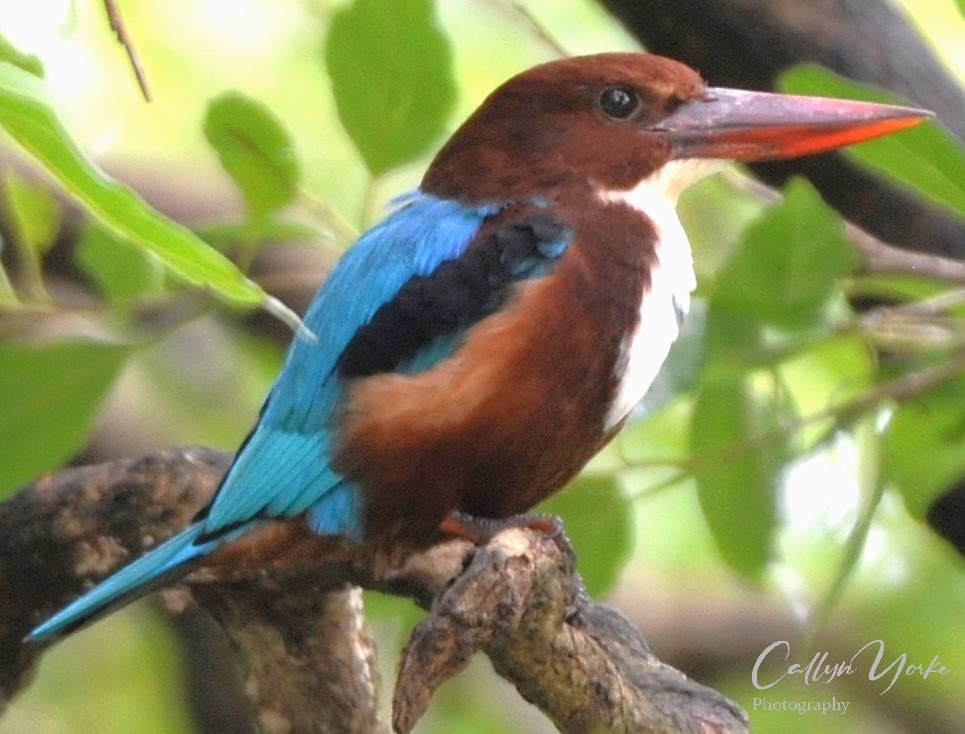
- Coppersmith Barbet Psilopogon haemacephalus 2 vocal in garden and forest edge trees, C, TPKL, TN-MR
- Yellow-crowned Barbet Psilopogon henricii 1 vocal, fr, in tall, garden tree (Ficus sp.?) near Chalet #50 with abundant, small yellow fruits; with several other frugivorous bird species, over a period of several days, UC, TN-MR
- Gold-whiskered Barbet Psilopogon chrysopogon 1 in same fruiting tree described in previous account, taking fruits briefly and flying off toward the forest, R, TN-MR
- Maroon Woodpecker Blythipicus rubiginosus 1 vocal, seen briefly from about 15m as it flew to a an upper-middle tree trunk, then off into the forest, R TN-SLT
- Orange-backed Woodpecker Chrysocolaptes validus 1 vocal, seen at close range (5m) as it alighted briefly on a lower-middle tree trunk, R, TN-SLT
- Common Flameback Dinopium javanense 1 (f) foraging in upper middle and subcanopy of tall trees surrounding parking area, KSNP (photo); 1 in middle on trunks, moving up, se parking and woodland, TPKL.
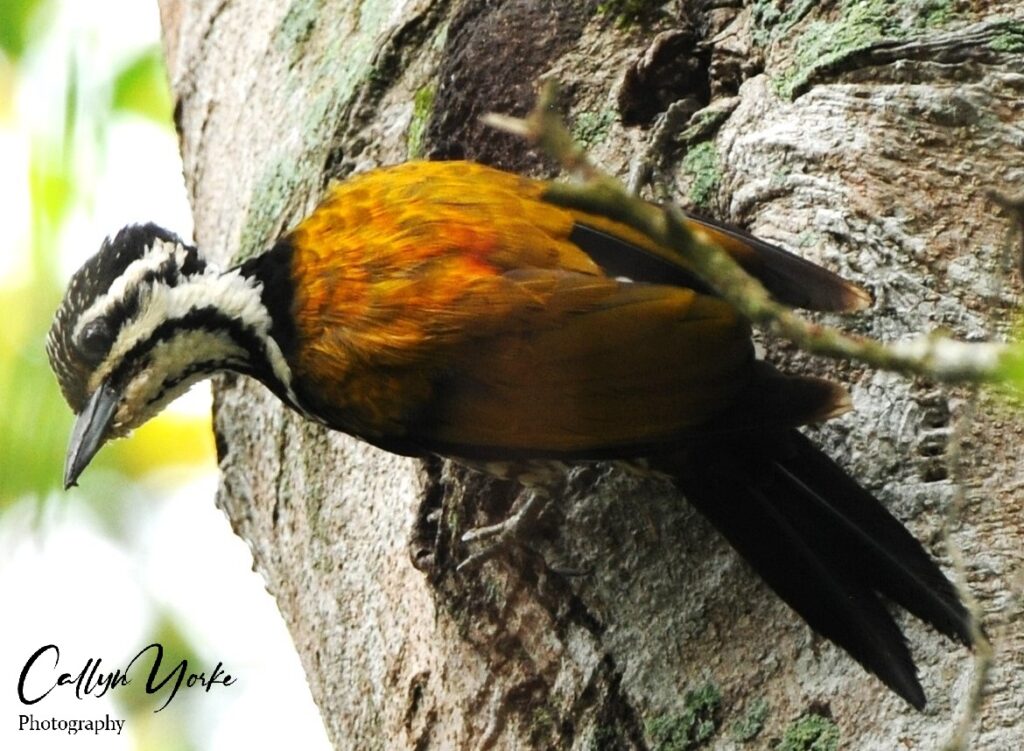
- Greater Yelownape Chrysophlegma flavinucha 1 flying quickly and alighting briefly on a series of small diameter tree trunks and limbs in forest understory next to a clearing, R, TN-LS
- Black and Yellow Broadbill Eurylaimus ochromalus 1 alighted in the subcanopy of tree overhanging the Tahan Hide; another seen in the canopy of a tall garden tree, UC, TN-TH, MR (photo).
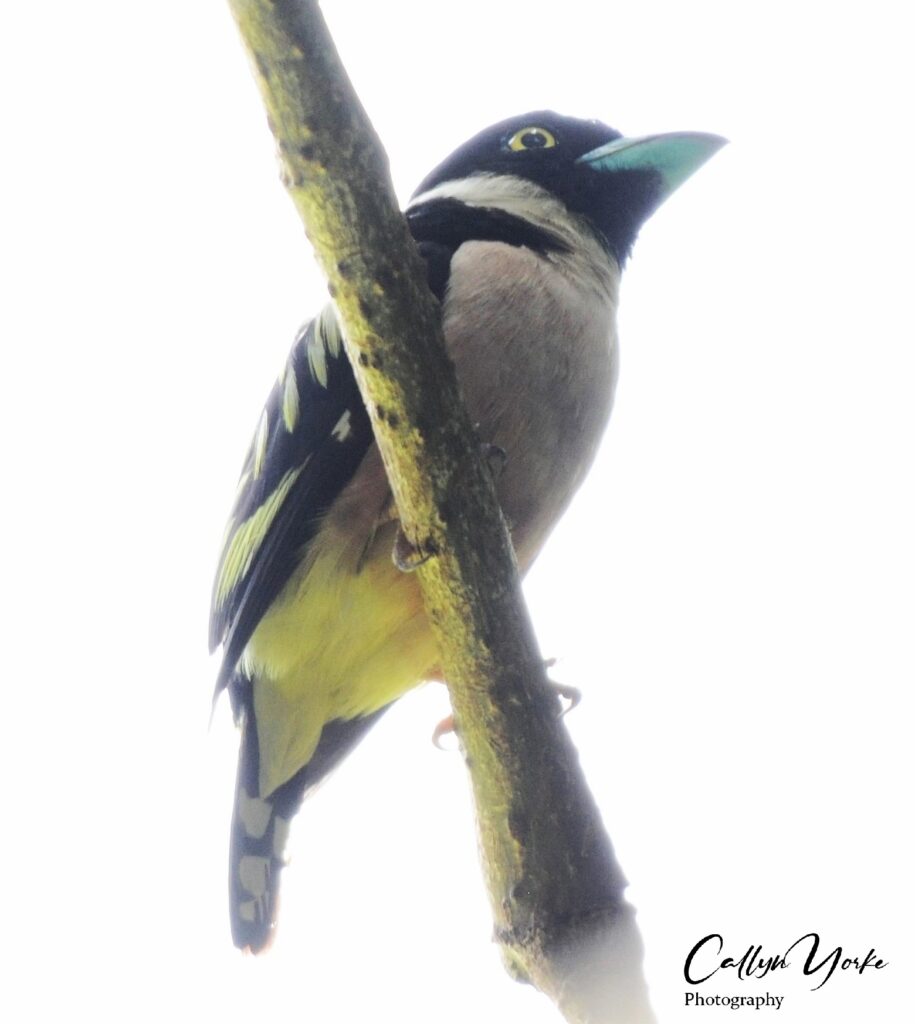
- Dark-throated Oriole Oriolus xanthonotus 1 in large, garden fruiting tree with barbets and other frugivorous birds, near cabin #50, R, TN-MR
- Black-naped Oriole Oriolus chinensis 4 vocal, loosely gregarious in canopy of tall fruiting tree, nw woodland edge, TPKL
- Black-winged Flycatcher-shrike Hemipus hirundinaceus 1 in msf with bulbuls and other insectivores, forest understory, R, TN-SWT
- Rufous-winged Philentoma Philentoma pyrhoptera 1 (f) flushed from lower mid-level in forest understory, R, TN-LS
- Common Iora Aegethina tiphia 1 vocal (unseen) forest, UC, TN-SWT
- Greater Racquet-tailed Drongo Dicrurus paradiseus 1 with one missing tail streamer, understory clearing, sallying to ground, TN-LS; 1 with complete tail streamers, 20m agl in subcanopy at forest edge, UC, TN-MR
- Blyth’s Paradise Flycatcher Terpsiphone affinis 1 (m) sallying in forest understory at edge of clearing, R, TN-LS
- Crested Shrike-jay Platylophus galericulatus 3 vocal, greg. seen at close range (5m) alighting briefly in understory palms and flying into the forest, R, TN-SWT
- House Crow Corvus splendens 30 vocal, greg. abundant and conspicuous in Kuala Lumpur; widespread in coastal towns and villages, C, TPKL
- Southern Jungle Crow Corvus macrorhynchos 1 vocal, flying 30m agl over Sungei Tembling toward Kuala Tahan, UC, TN-MR; KSNP
- Common Tailorbird Orthotomus sutorius 3 highly vocal, but rather secretive in dense second-growth, gardens and forest edge, TPKL; C,TN-MR
- Barn Swallow Hirundo rustica 2 flying back and forth, low over river, UC, TN-LS; TPKL
- Pacific Swallow Hirundo tahitica 4 greg. flying low, dipping into surface of river, C, TN, MR; 1, flying 20 m agl over open area at park entrance, KSNP
- Stripe-throated Bulbul Pycnonotus finlaysoni 3 vocal, greg. fr in second-growth and forest understory, canopy of fruiting trees, C, TN-MR
- Yellow-vented Bulbul Pycnonotus goiavier 10 vocal, greg. in garden shrubs and trees, C, TPKL; KSNP
- Olive-winged Bulbul Pycnonotus plumosus 2 vocal (unseen) edge of secondary forest-mangrove; second-growth at edge of riparian lowland forest, KSNP; TN-MR (photo).
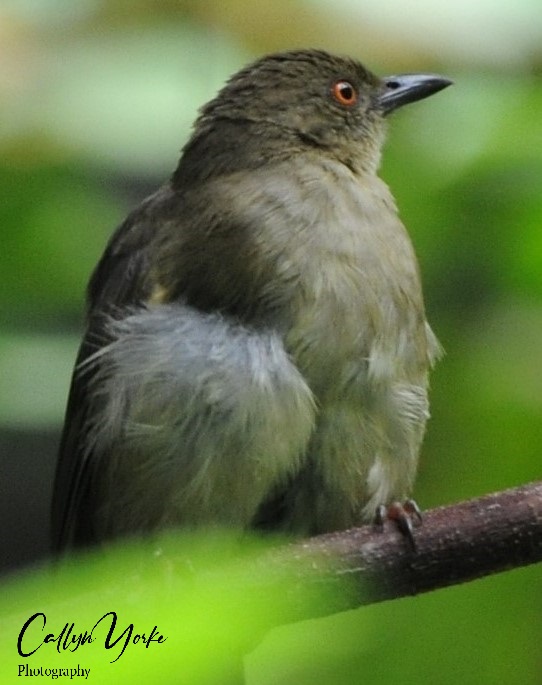
- Cream-vented Bulbul Pycnonotus simplex 1 in fruiting trees at edge and interior of forest; R, TN-MR
- Red-eyed Bulbul Pycnonotus brunneus 3 vocal, greg. often in fruiting trees with other bulbuls, forest edge and gardens, C, TN-MR (photo).
- Finsch’s Bulbul Alophoixus finschii 2 forest understory and lower mid-level in msf with babblers, UC, TN-SLT
- Ochraceous Bulbul Alophoixus ochraceus 2 greg. pairs in understory and lower mid-level of forest in msf with babblers, UC, TN-SLT
- Gray-cheeked bulbul Alophoixus tephrogenys 2 a pair in lower mid-level of the forest, R, TN-SLT
- Buff-vented Bulbul Iole crypta 4 vocal, greg. in fruiting garden and forest trees, understory to canopy, C, TN-MR
- Arctic Warbler Phylloscopus borealis 1 (ID with aid of digital photos; pale greenish brown upperparts, whitish undersides; bold, whitish supercilium extending to hind-crown) ig very busily in outer, sun-lit, foliage of large tree next to dining area, UC, TN-MR
- Pin-striped Tit-babbler Mixornis gularis 2 vocal (usually unseen) in garden trees and forest edge, C, TN-MR
- Sunda Scimitar-babbler Pomatorhinus bornensis 1 in msf with other babblers, mostly subcanopy in upper-mid level of forest, R, TN-SLT (photo).
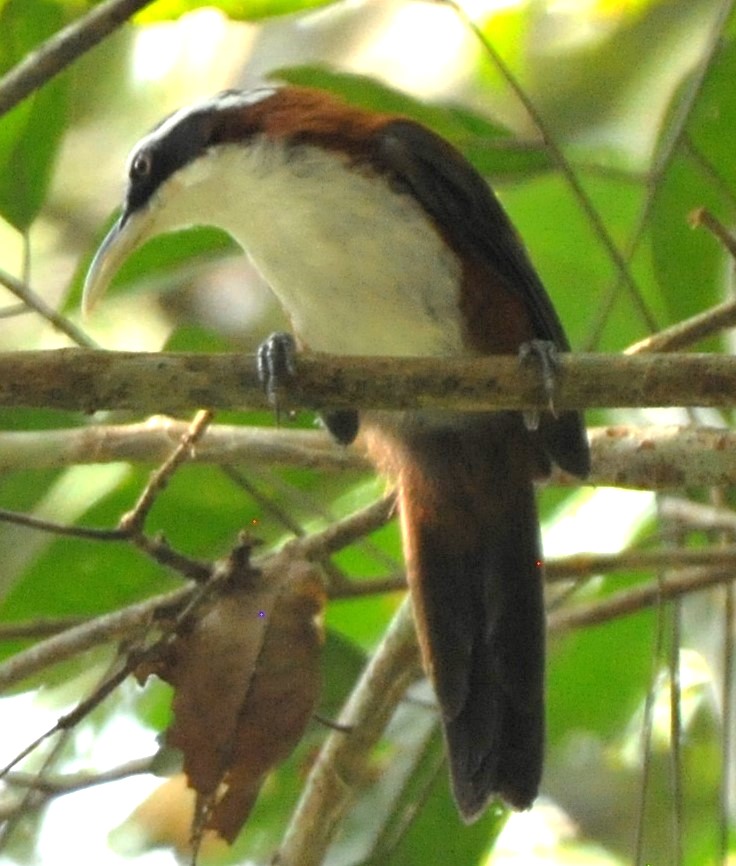
- Southern Gray-throated Babbler Stachyris larvata 2 greg. in pairs in forest understory, lower to mid-level, often in msf with other babblers, UC, TN-SLT; LS
- Chestnut-rumped Babbler Stachyris maculata 1 in msf with other babblers, forest understory, R, TN-STL
- Gray-headed Babbler Stachyris poliocephala 1 seen very briefly in dense understory tangles, msf with other babblers, R, TN-LS
- Rufous-crowned Babbler Malacopteron magnum 1 in large msf with babblers and flycatchers, understory to lower mid-level in the forest, UC, TN-SLT (photo).
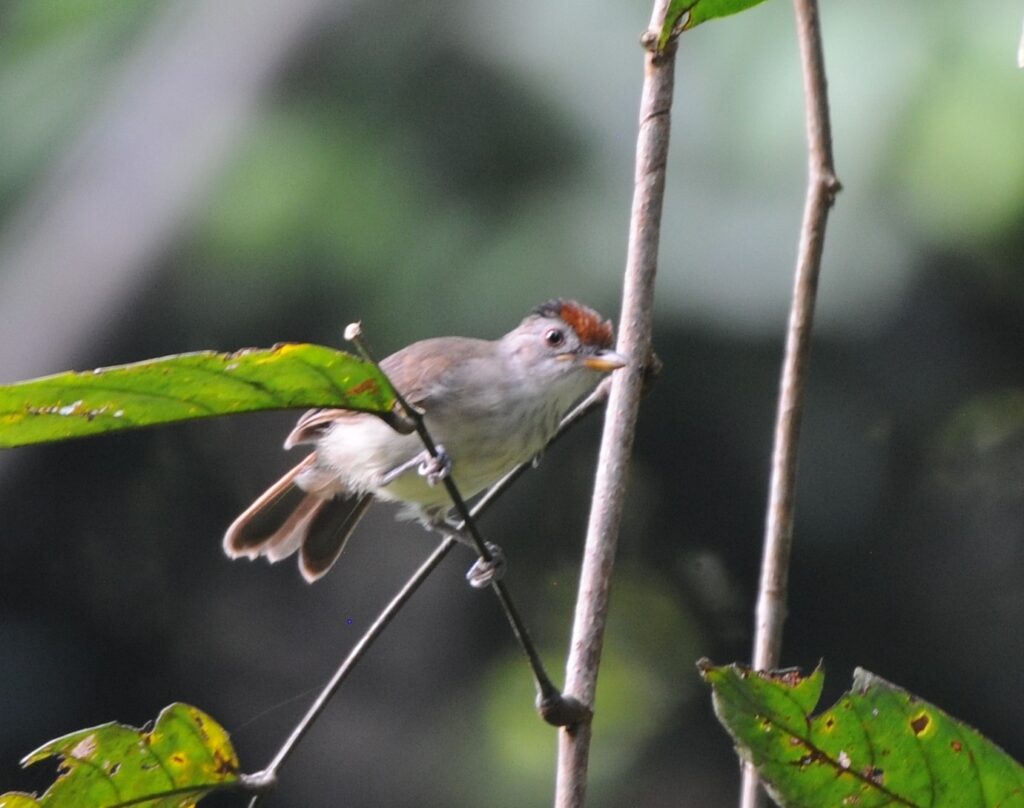
- Abbott’s Babbler Malacocincla abbotti 2 vocal, active in understory and forest edge, C, TN-LS, STL
- Horsefield’s Babbler Malacocincla sepiaria 2 greg. active in understory of forest, R TN-STL
- Black-capped Babbler Pellorneum capistratum 2 a pair busily foraging on the shady forest floor, behavior suggesting small quail; found the following day at about the same time and place, near the Tahan Hide junction, UC,TN-SLT
- Short-tailed Babbler Pellorneum malaccense 2 a pair, pitta-like in profile and posture moving through understory an lower mid-level of forest, perched on small diameter limbs, R, TN-SLT
- Asian Glossy Starling Aplonis panayensis 6 (m,f) greg. in canopy of tall fruiting tree, nw, TPKL; 50 (m,f) greg. presumably an evening pre-roosting flight over tall trees at the park entrance, KSNP
- Purple-backed Starling Agropsar sturninus 12 greg. pairs engaged in interspecific flight- chases in and around canopy of fruiting tree, nw TPKL
- Common Myna Acridotheres tristis 12 pairs on lawns and on wet ground in woodland, C TPKL (photo).
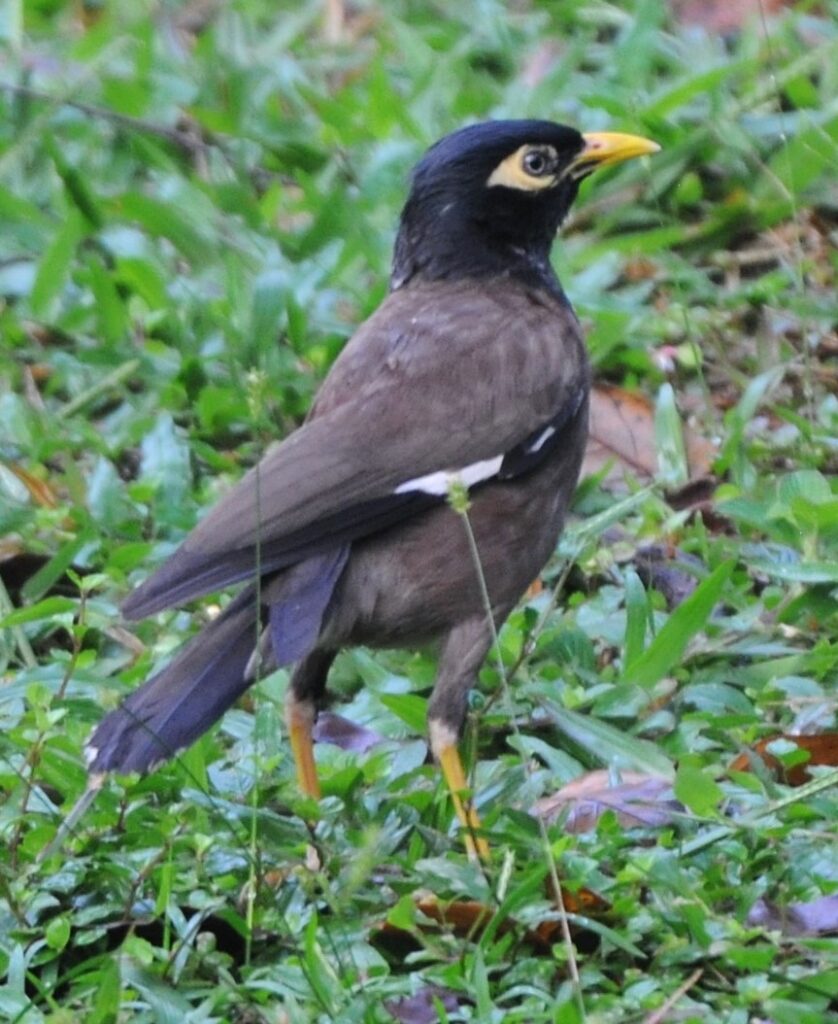
- Javan Myna Acridotheres javanicus (exotic) 20 greg. often in pairs, foraging on ground and lawns; one albinistic individual foraging alone in grass, C, TPKL (photo).
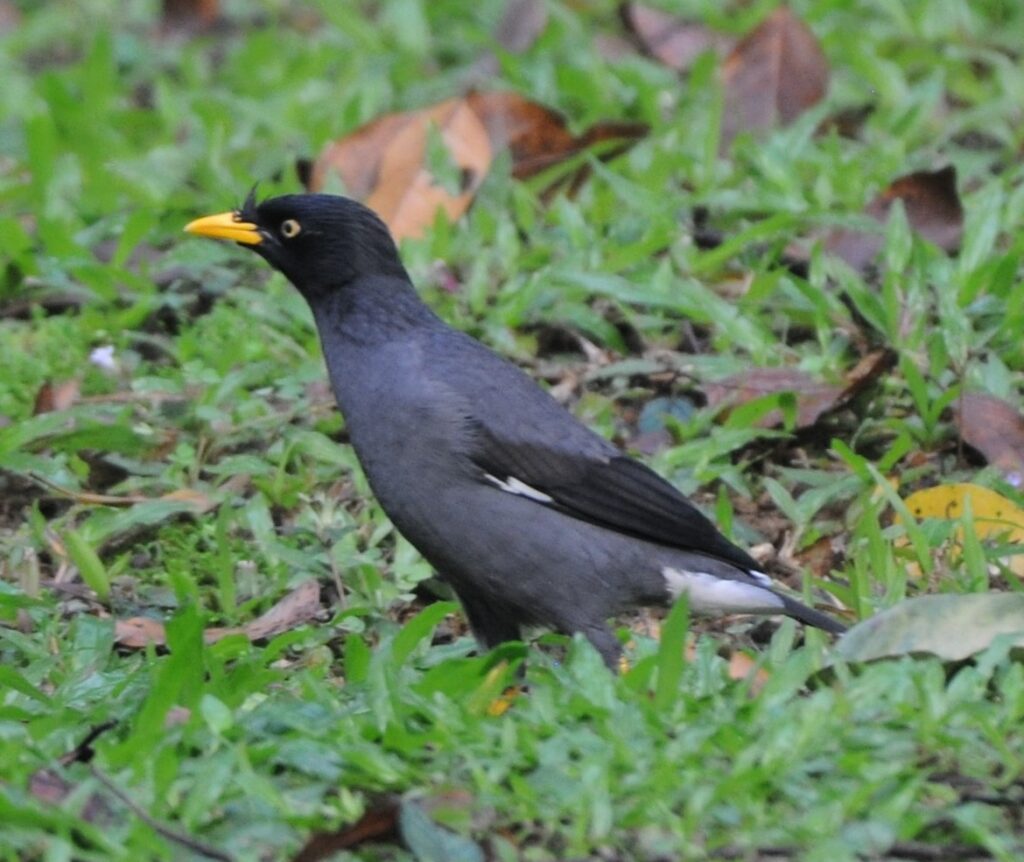
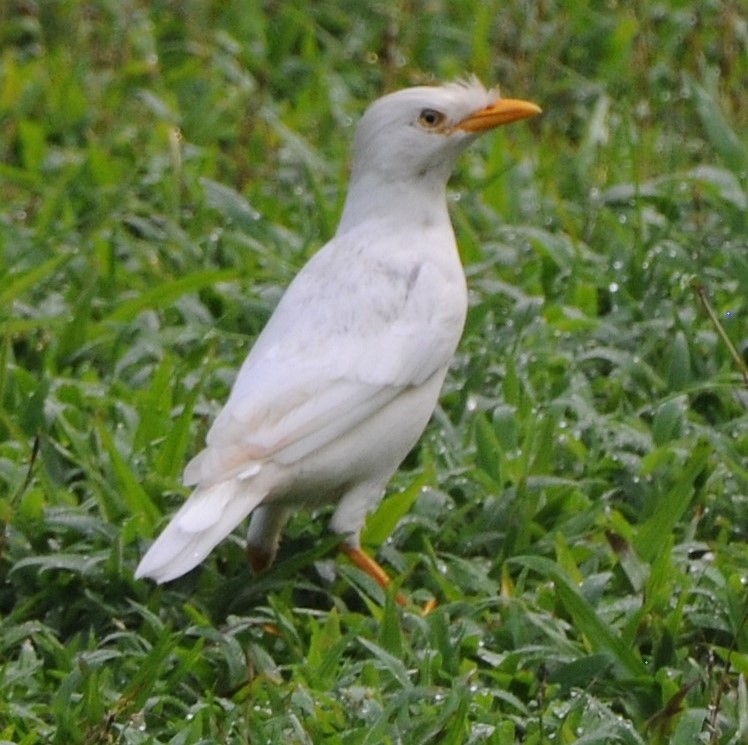
Oriental Magpie Robin Copsychus saularis 6 vocal, greg. at dusk in garden and forest edge, C TN-MR; 4, C, TPKL; 2 KSNP
- White-rumped Shama Copsychus malabaricus 1 flew from ground at trailside to concealed perch in understory palm, R, TN-STL
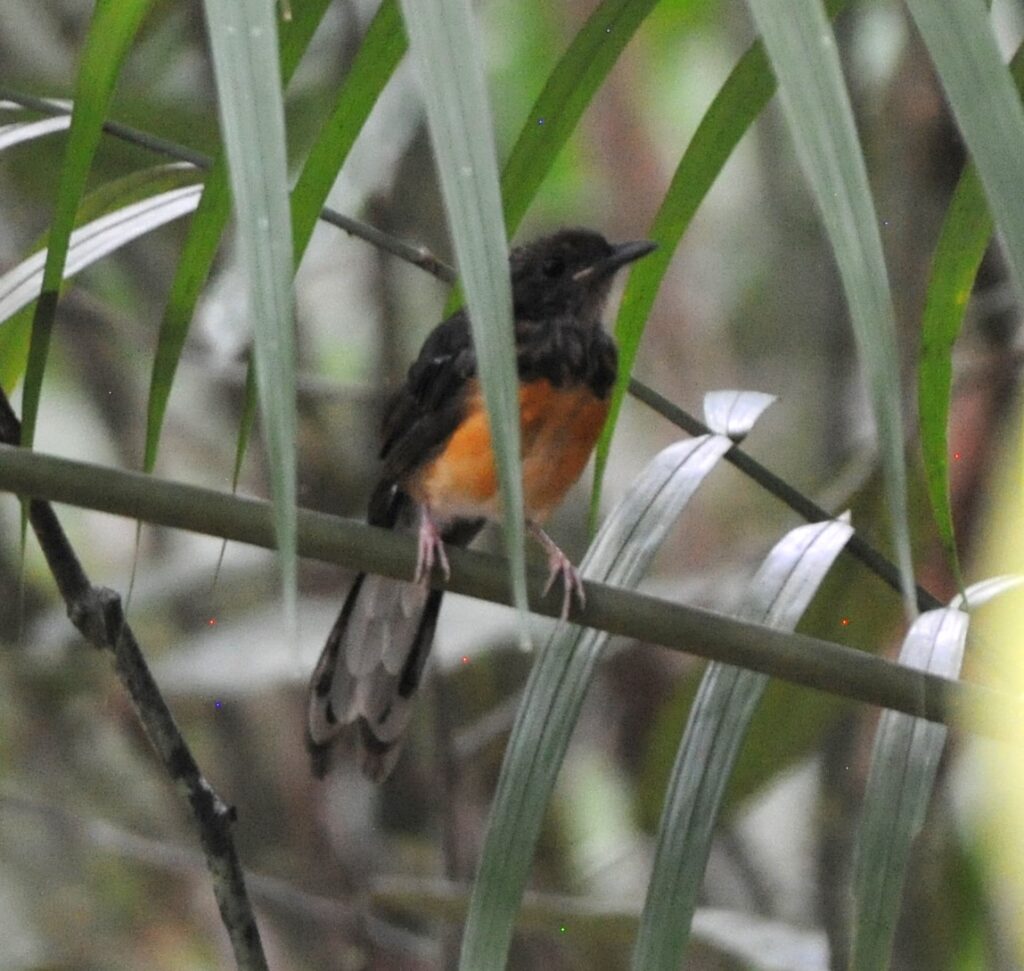
- White-crowned Forktail Enicurus leschenaulti 1 vocal (alarm call when flushed) drinking and walking along shallow, swamp stream beneath palms, R, TN-SLT
- Yellow-rumped Flycatcher Ficedula zanthopygia 2 (m,f) a pair flashes of yellow and black, in understory of dense tangles in a msf; recently reported in the area by a visiting birding group R, TN-LS, SLT
- Scarlet-backed Flowerpecker Diceaem cruentatum 1 (m) in fruiting garden tree, UC, TN-MR
- Orange-bellied Flowerpecker Dicaeum trigonostigma 1 (f) in same tree with SBFP, UC TN-MR
- Thick-billed Flowerpecker Dicaeum agile 1 fr in fruiting tree with SBFP, R, TN-MR
- Purple-naped Spiderhunter Kurochkinegramma hypogrammicum 2 a pair moving quickly through the lower mid-level of the forest, alighting briefly on a small limb, R, TN-SLT
- Thick-billed Spiderhunter Arachnothera crassirostris 1 fr on yellow bottlebrush tree, shared alternately with SPSH two days in a row, UC, TN-MR (photo).
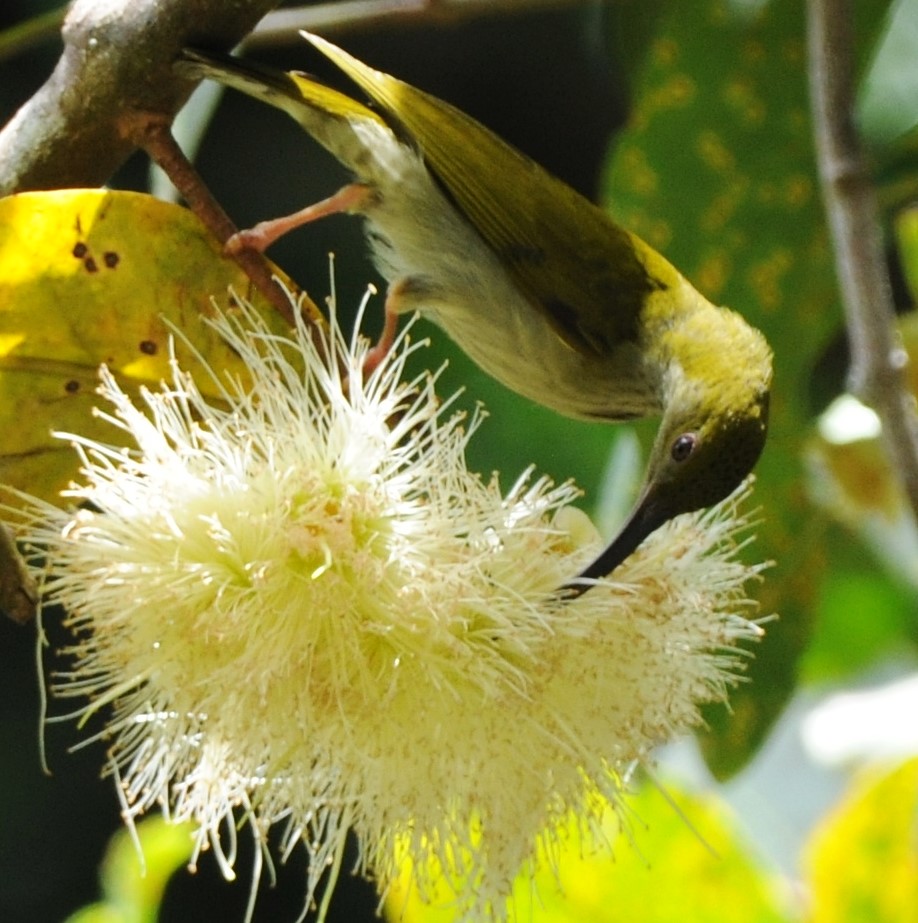
- Spectacled Spiderhunter Arachnothera flavigaster 1 fr in same flowering tree but at different times as TBSH, UC, TN-MR (photo).
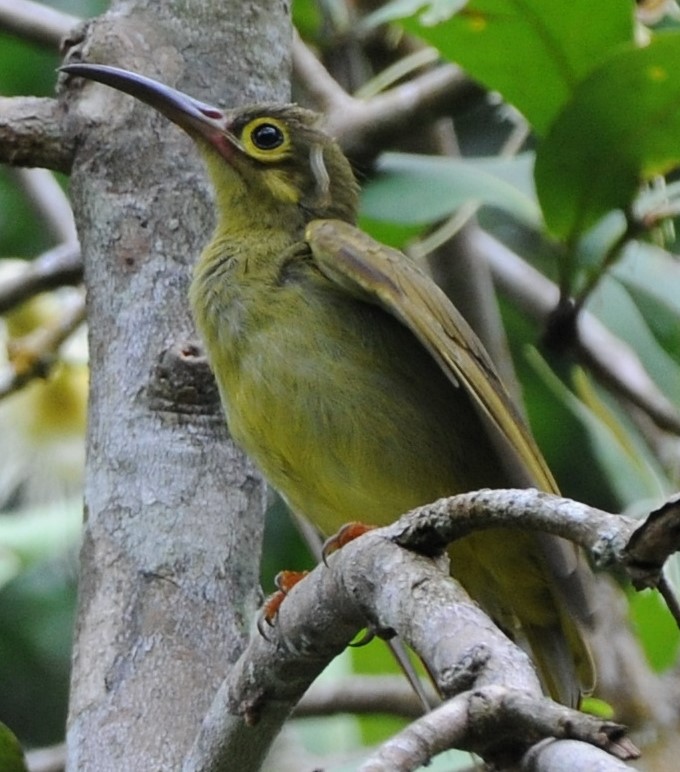
- Asian Fairy Bluebird Irena puella 2 (m,f) fr in heavily fruiting garden tree near cabin #50, msf with several other frugivorous birds for three to four consecutive days, C, TN-MR
- Lesser Green Leafbird Chloropsis cyanopogon 2 a pair in outer canopy of tall garden tree, UC, TN-MR
- Blue-winged Leafbird Chloropsis cochinchinensis 2 a pair alternating fr in small berry tree next to reception area for several consecutive days, C, TN-MR (photo).
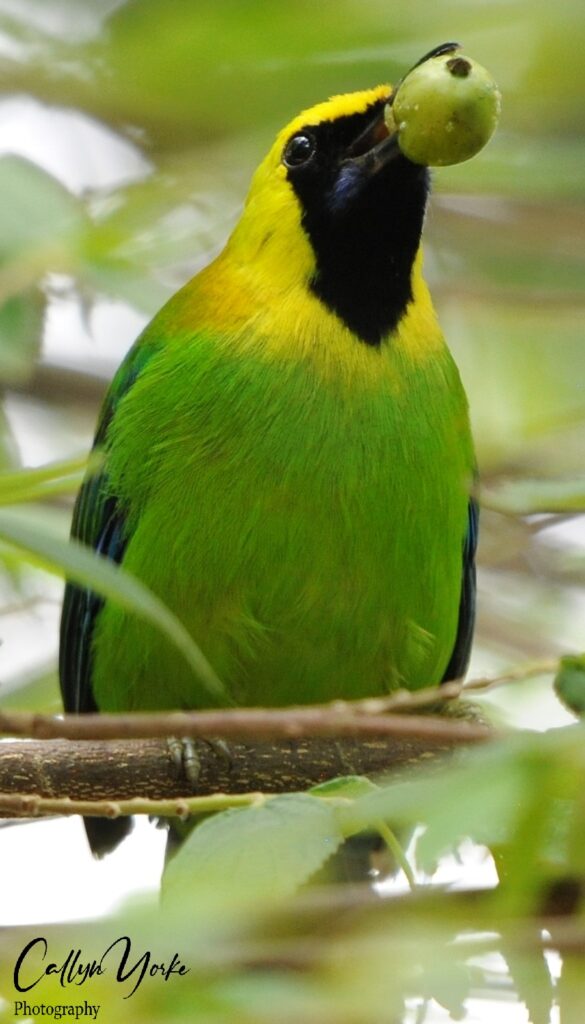
- Eurasian Tree Sparrow Passer montanus 30 (m,f) vocal, greg., on ground and in trees, disturbed habitats, villages, towns & cities C, ubiq. (not observed in TN).
_______________________________________________________________